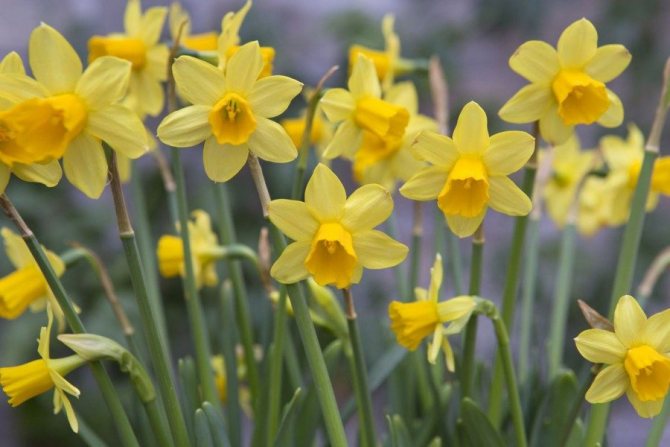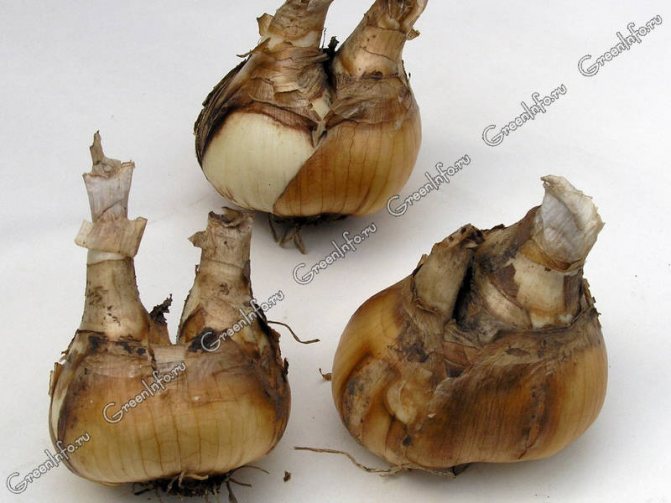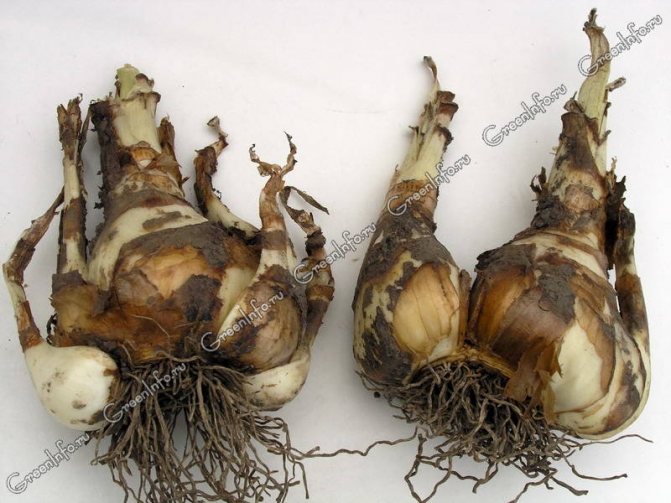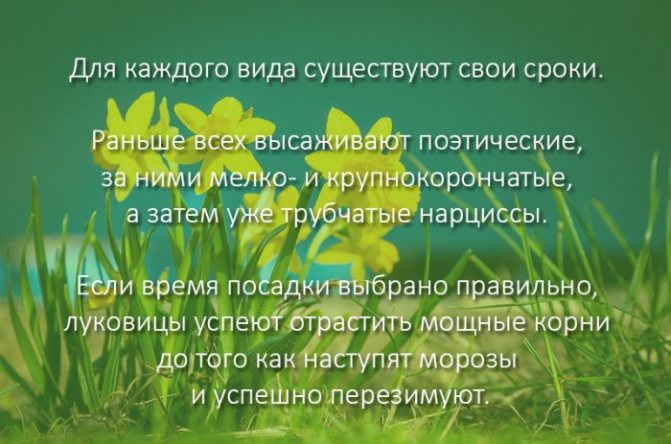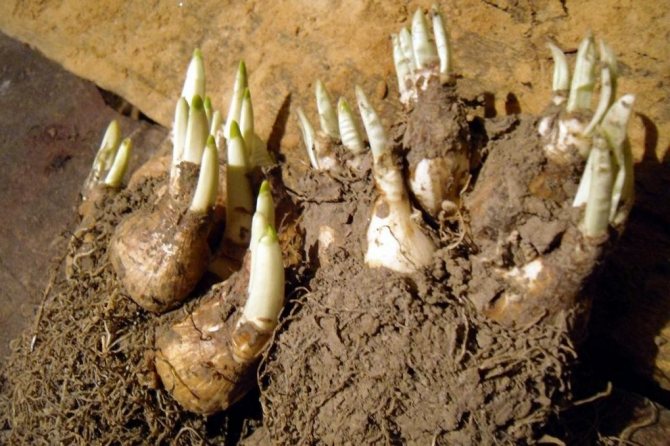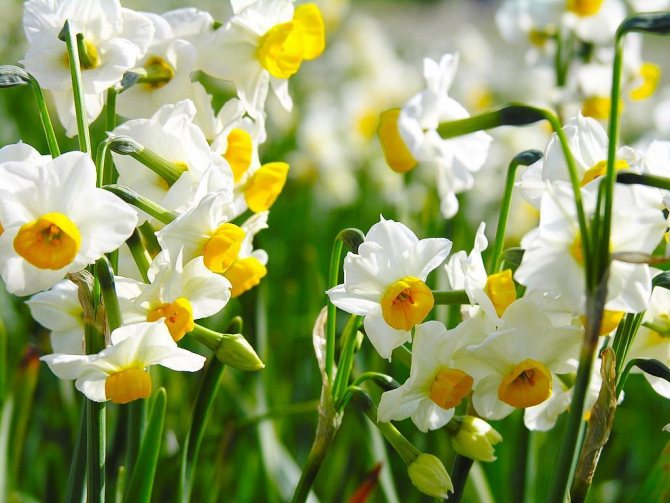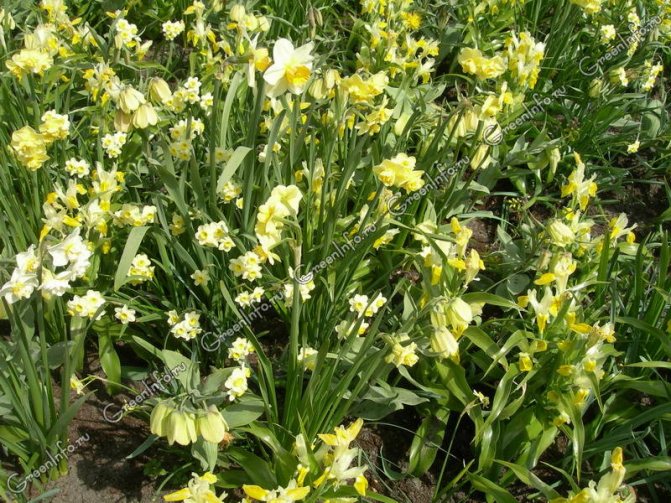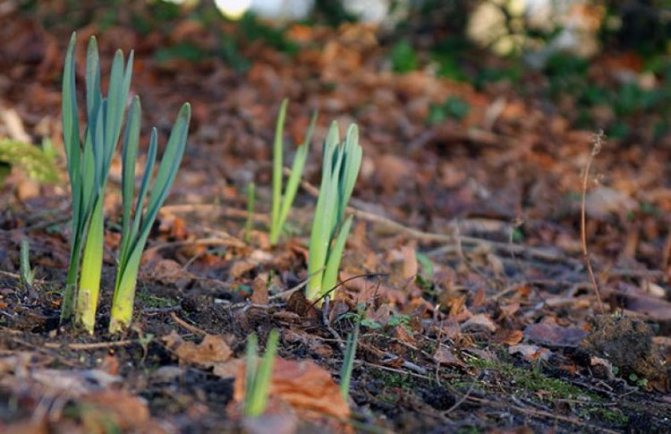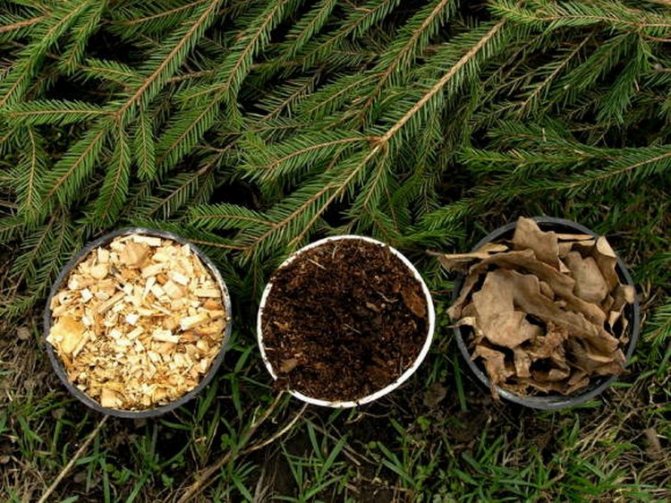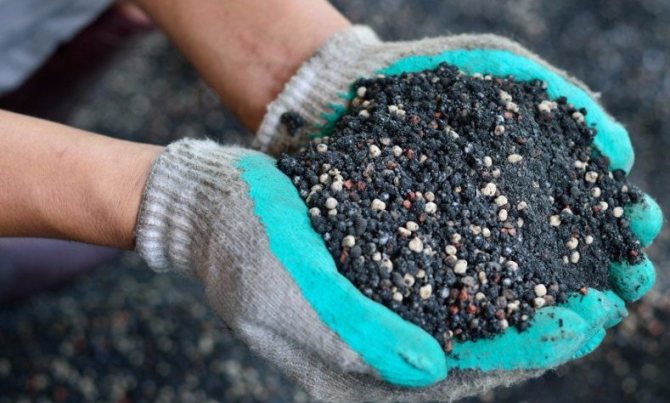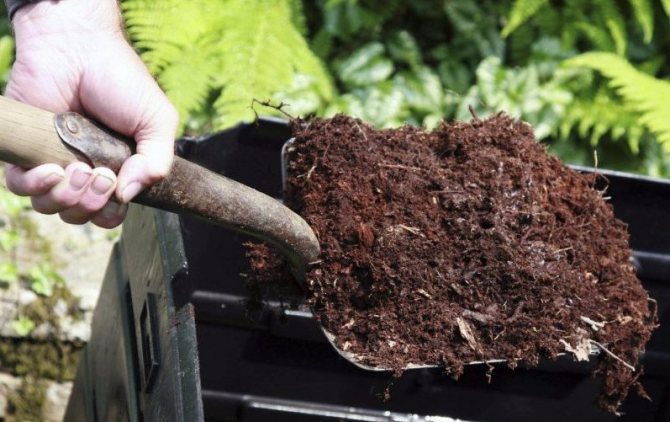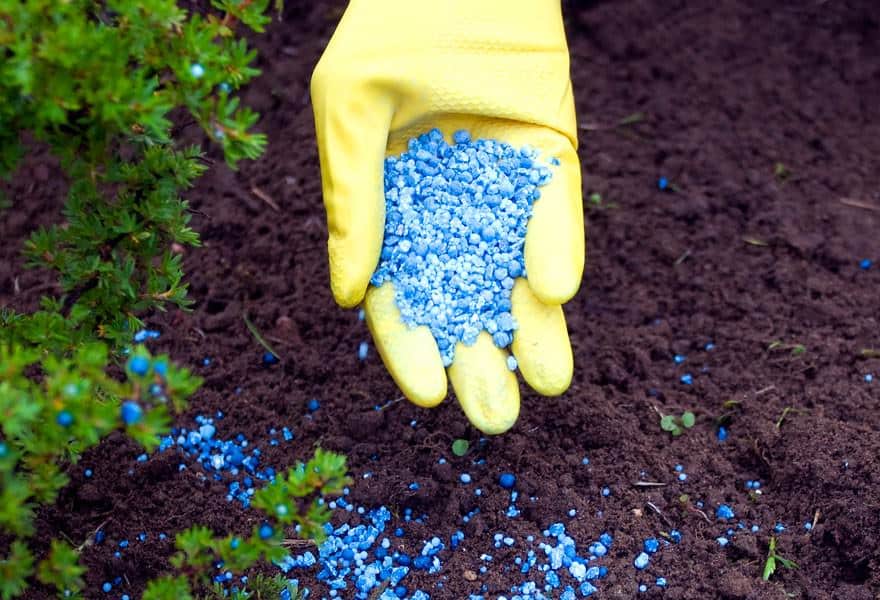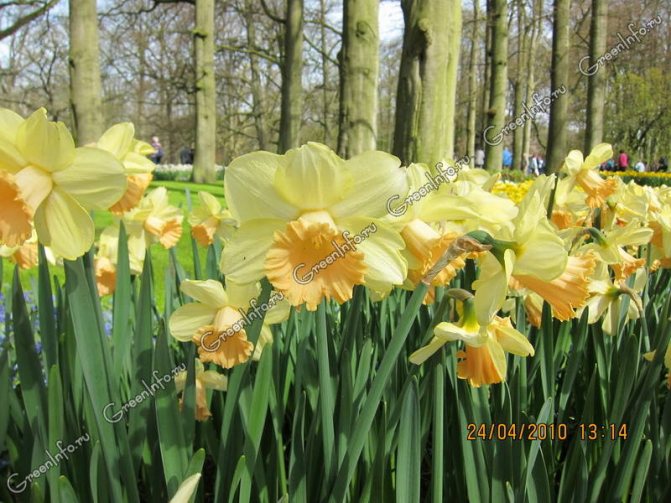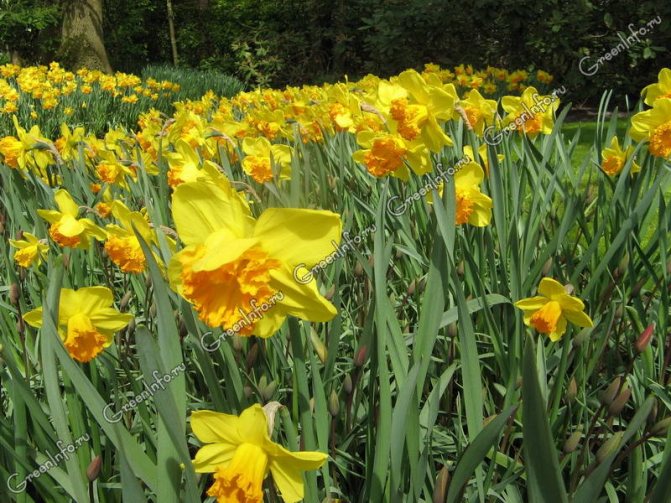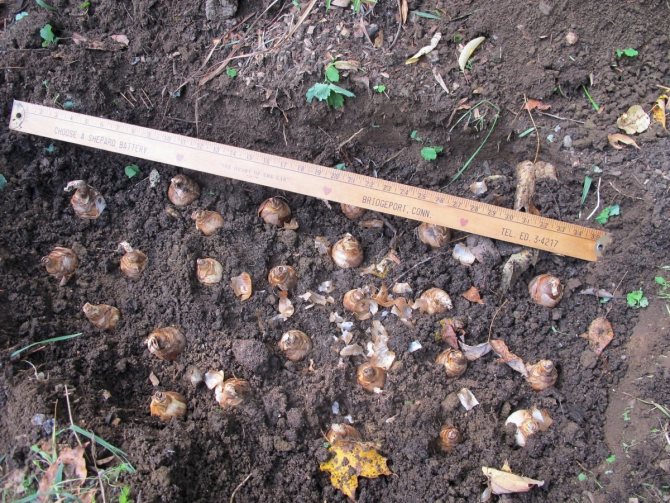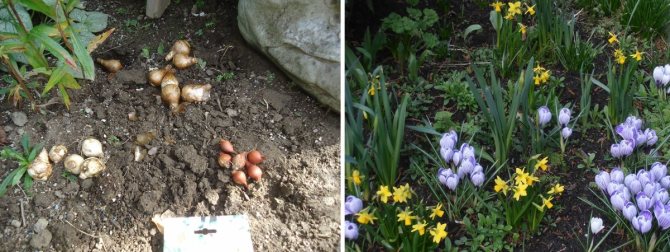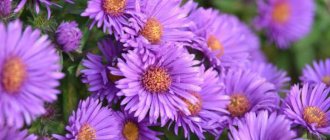Daffodils are delicate spring flowers that are grown for cutting and decorating the garden. They look great in mixborders and on alpine slides, lawns, flower beds, rabat beds. In the regions of the middle lane, the flowering of daffodils begins towards the end of April and continues until mid-May. By the beginning of July, the growing season of the aboveground part stops, the plant dries up, only the bulb in the ground remains alive. It is customary to plant flowers in the fall. Let's talk about what this is connected with and what terms can be considered optimal.
When to plant daffodils in autumn and spring: optimal timing
The timing of planting daffodil bulbs in the fall is determined by the weather and climatic conditions of your region of residence. It is advisable to plant flowers a month before the onset of the first frost, so that they have time to take root in a new place. At the same time, it is extremely important that by the time of disembarkation the temperature has already dropped to + 8-10 degrees and stably kept at this level for 10-14 days. Therefore, in the Central lane (Moscow region), it is optimal to plant daffodils in open ground in September. But in the Urals and Siberia, it is better to start early, already at the end of summer - in the second half of August.
Daffodils can also be planted in spring, when the soil temperature warms up to + 5-7 degrees, that is, around April-early May, depending on where you live.
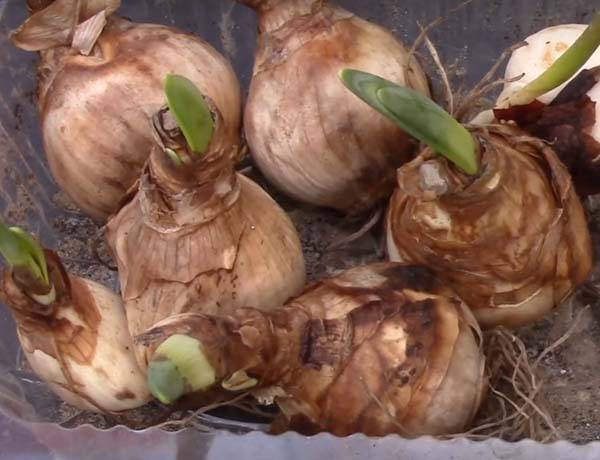
Important! If you plant daffodils in the spring, they will no longer bloom this season, so all bulbs are usually planted in the fall. Another thing is, if you were presented with bulbs or flowers driven out in a pot, then in order to preserve them, you will have to plant them in the spring. And next year they will definitely bloom.
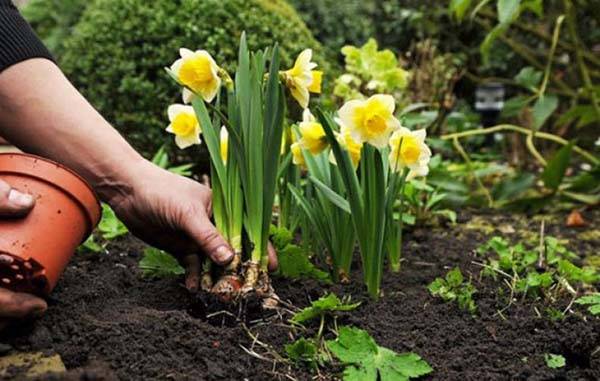

Video: how to plant daffodils in spring and what to do with them before disembarkation
When to plant
The timing of planting daffodils in the fall can vary greatly due to climate. Experienced gardeners are advised to start planting at a temperature of 8-10 degrees Celsius. The temperature should be kept after planting for another 10-14 days. For the north, the Moscow region or the middle part of the Russian Federation, such weather can be expected around the middle or end of September. For the southern regions of the country, this period can last until the last days of October or early November.
Important! If these deadlines are not met, you can not wait for the daffodil flowers in the spring.
If these bulbous plants are planted earlier, they may grow back and freeze during frost. If the bulb is planted on time, then it should harden before the onset of frost, but its upper part, in no case should have time to germinate.
If the daffodils were planted in warmer weather and high humidity (50-100% higher than the norm), then the bulb can rot. Planting daffodils later than the right time in the fall can cause the flowers to produce low flower stalks and too small buds. Therefore, at a later planting, it is recommended to carefully cover the daffodils so that the bulbs do not freeze the very first cold.
Some varieties of these plants are quite frost-resistant and do not require insulation. But experts still advise covering daffodils for the winter whenever possible, regardless of their variety. Suitable shelters for daffodil bulbs are spruce branches, peat, leaves, sawdust or compost, as well as any other breathable organic material.You can also use a nonwoven fabric for quick shelter from the elements. As for the plastic wrap, it severely restricts the flow of air.
How to choose quality daffodil bulbs
In order to definitely not have problems with growing daffodils, you need to initially purchase high-quality planting material.
It is best to buy bulbs in late summer - early autumn, so that you can plant them right away, and not deal with their storage.


Signs of a quality daffodil bulb are:
- the presence of dry scales that have a brown or golden hue;
- dry and even bottom;
- absence of any physical damage, signs of disease, various spots and molds;
- good density to the touch;
- normal size (small bulbs = small flowers).
If a sprout has already hatched from the bulb, or it has been dug up along with a peduncle and a stem, on the lower part of which the presence of small bulbs is noticeable, then such planting material is not suitable, you should not take it.
Features of a narcissist
The flowering narcissus plant has dense bulbs and 2–4 ribbon-shaped leaf plates of different widths. Basal leaf plates of a linear shape appear before the peduncle. Leafless stems can be round or flattened, there is a film drag on their surface. At the top of the stem, a flower is formed. Different types of narcissus have different bulb shapes, they can be oval, ovoid, pointed or round. In some species, the bulbs form a nest; on one bottom, several bulbs are formed, which are wrapped in colored scales. Every year, the old roots of the bulbs die off, and new ones grow in their place, the lifespan of the roots is no more than 10 months. Drooping or straight flowers can be part of the umbellate racemose inflorescence in the amount of 2-8 pieces or be single. The shape of the petal-shaped perianth is a tubular funnel, passing in the upper part into a horizontally located limb.
Fresh articles for gardeners, gardeners and florists
How to grow petunia from seeds at home for seedlings
Planting carrots in spring sowing when to sow how to plant correctly
Lunar calendar for april 2019 of the gardener and gardener
Pruning an apple tree in spring for beginners in pictures step by step
The bridle can have a tubular, bell-shaped or cupped shape; it is formed by outgrowths of the perianth lobes, which are most often painted in a different shade. Flowers can be yellow or white. There are also species and varieties with two-color flowers. In diameter, they can reach 20–100 mm. The fruit is a three-nested box with seeds inside. Most often, the bushes reach a height of 0.1 to 0.5 meters. You can decorate your garden with daffodils, and if you wish, you can also grow them at home. Flowering is observed in April – May.
How to plant daffodils outdoors: rules and recommendations
Daffodils will bloom richly and fragrant if you think carefully about the choice of a place and the preparation of the beds and the bulbs themselves for planting.
Seat selection
It is advisable to choose a place for growing daffodils that is well heated by the sun and relatively protected from the wind, although in light partial shade they will grow and bloom well every year. Even when choosing a site for planting, it is important to remember that low-lying places are not suitable, since due to high humidity, the bulbs can easily rot.


With tulips
It is beautiful to plant daffodils in a flower bed next to tulips, hyacinths and crocuses. Also, an interesting neighborhood will be with peonies.
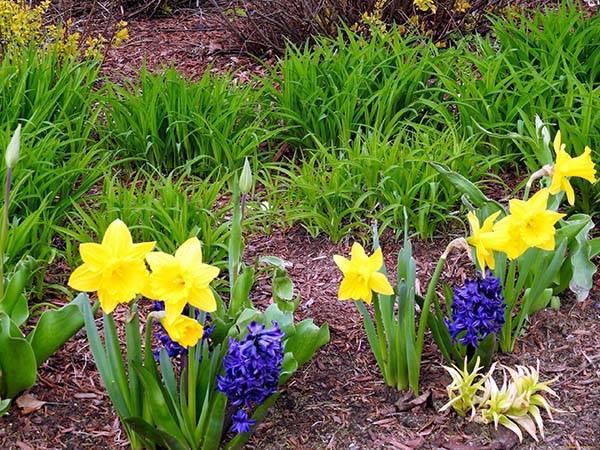

With hyacinths
Some summer residents like to plant early flowering bulbs under trees.
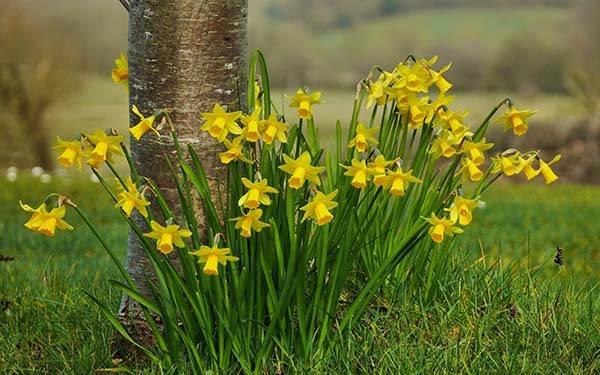

Site preparation for planting
It is advisable to prepare the soil and the site for the autumn planting of any crops in advance.Ideal if it is loam.
And if you have sandy soil, then a month before planting the bulbs, the garden bed should be dug 20-25 centimeters (shovel bayonet) and added per 1 sq. m. 5 kg of peat, rotted compost or humus.
Heavy soil should be made looser with sand and humus or well-rotted compost.
Daffodils grow well in neutral soils. If your soil is acidic, then you can deoxidize it with the help of pre-ground or limestone flour or wood ash.
It will not be superfluous for digging to apply complex fertilizer - per 1 sq. m. 2 st. spoons (30-40 grams) of superphosphate.
All bulbs require drainage, unless, of course, you are planting in sandy soil. That is why it is advisable to pour a small layer of sand at the bottom of the planting pit. It must always be remembered that if the water stagnates, the bulbs will get wet and rot.
Preparing the bulbs
To avoid possible diseases, daffodil bulbs should be treated in one of the solutions before planting. For example, a solution of potassium permanganate or the drug "Maxim Dachnik" is excellent for etching bulbs, and "Fitosporin" is also suitable. In any means, the onions need to be held for an average of 20-30 minutes.


Direct landing
Step-by-step instructions for planting daffodils in open ground:
- Decide on a planting spot in your garden.
- Prepare the beds, apply the necessary fertilizers.
- Pickle the bulbs to disinfect the planting material and prevent possible diseases.
- Make planting holes. The planting depth of daffodil bulbs depends on their size and soil composition. The classic rule for planting all bulbs is that the planting depth should be 3 bulb heights. If the soil is light, then the depth can be increased by 2-3 centimeters, if it is heavy, then reduced by the same amount.
- The distance between the bulbs should be about 15-20 cm.


- If your soil is not light and permeable enough, then pour a small layer of sand on the bottom.
- Place the bulbs in the holes (sprouts up), and then lightly press into the sand and cover with fertile soil.
- Water it moderately.
- Mulch the planting. Sawdust, peat or the same humus are suitable as mulch. You can also use cones, thereby you will well highlight the planting site.
Video: autumn planting of daffodil bulbs in open ground
How to properly distill daffodils
The method to achieve optimal early flowering of daffodils is called forcing. This technology will allow you to receive flowers by a certain date. Forcing is easiest to do in greenhouses, since temperature and humidity are important in this process. However, there are examples of successful distillation in pots.


To prepare the plant for distillation, it is necessary to prevent the plant from blooming; for this, the peduncles are cut off in the early stages. This is done so that the bulb has accumulated enough strength before forcing. Since the forcing technology itself will be stressful for the plant, because forcing will stimulate not only flowering processes, but also accelerate the growing season until new children are formed.
One way to distill daffodils consists in preparing the bulbs. It is necessary to select healthy large bulbs and dry them for two weeks at a high temperature (+28 - 30 degrees). Then the temperature is gradually reduced to 17 degrees, the humidity is raised to 90%, and then placed in the refrigerator. It should be remembered that it is impossible to freeze the bulbs, the optimal temperature is considered to be at least +8 degrees.


Daffodils are planted no earlier than a month before the estimated time of flowering. The bulbs are planted either in a greenhouse or in pots with prepared soil.In the greenhouse, the planting of the bulbs is carried out as usual, the main thing is not to deepen the plant too much, it is considered optimal when, when planting for distillation, the top of the bulb rises above the ground. The temperature during distillation for the first week should not exceed + 10 degrees, and the subsequent increase to 18 degrees should take place gradually. In such conditions, the plant is kept until flowering. Caring for daffodils when forcing is no different from those growing outdoors. The main thing is not to expose the plant to high temperatures, otherwise the bud will crumble, and the active development of the leaves will begin to oppress the peduncle. Another trick is to lower the temperature by three to four degrees during flowering, this will prolong the life of the flower.
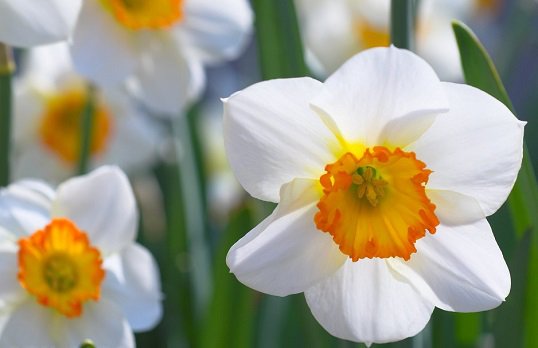

Another way to drive out daffodils. This method differs little from the usual planting of daffodils, they are not stored in special conditions, they are not refrigerated. Two months before the desired flowering, the bulbs are planted in prepared boxes filled with sand and installed in a dark basement with high humidity. In such conditions, the bulb is activated and sprouts. After germination, the boxes are moved, and another well-lit room with a temperature not exceeding 17 degrees. And in a few weeks, flowers will delight you. The main thing is not to forget about regular watering and feeding, otherwise the bulb will deplete. If you want daffodils to bloom for a long time, keep the temperature at the same level, not exceeding the +11 degrees mark.
Outdoor daffodil care
If you take proper care of the daffodils, these wonderful blooms will grow well and delight you with abundant flowering. To do this, you only need to follow the standard care recommendations: water moderately, feed regularly, weed and loosen if necessary.
Daffodils love watering, especially in early spring, during the period of the beginning of growth and formation of green mass, budding and flowering, as well as at the end of it (it is at this time that the bulb is stocked with food).
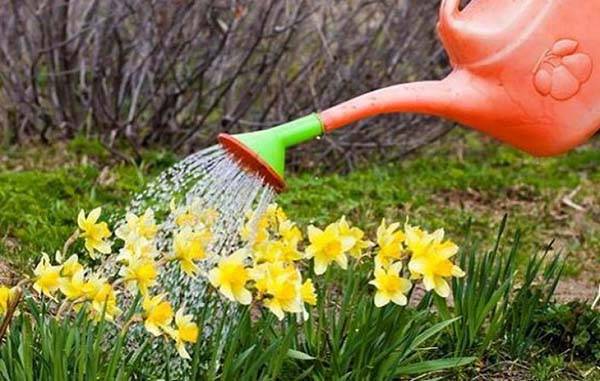

For better flowering, daffodils should be fed several times:
- In early spring, when the first greens appear, ammonium nitrate or nitrophos or some other nitrogen fertilizer. You can also make a green fertilizer (herbal infusion).


- During the period of bud formation - potassium-phosphorus fertilizer.
- During the flowering period - also a fertilizer with a high content of potassium and phosphorus.
- After flowering, it is recommended to apply phosphorus fertilization. Superphosphate is ideal.
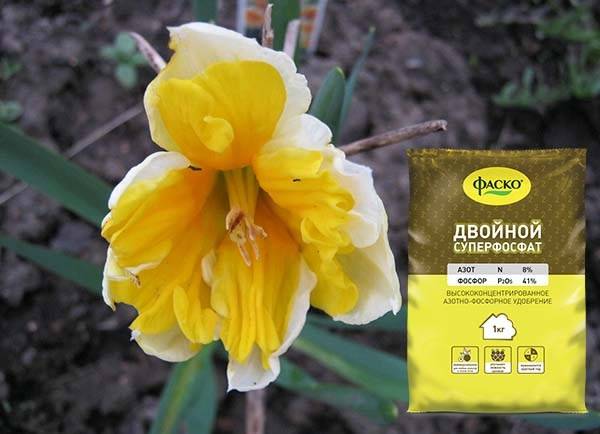

Note! In order not to burn the root system of the plant, it is advisable to water it before feeding.
So that the plant does not waste its energy senselessly, its fading buds (future seed boxes) should be removed in time. And then you can beautifully weave braids from the remaining leaves (they cannot be cut off, through them the bulbs accumulate nutrients).


Video: what to do with daffodils after flowering
Digging the bulbs
Daffodil bulbs should be dug out at least once every 5-6 years, although, for example, the same tulips - once every 3 years. It is possible and more often, but if you accidentally damage them a little, then there will be a very high probability of the disease. In other words, these bulbs do not like to be touched and transplanted once again, however, this must be done once every 6 years, otherwise the flowers are too crushed and become simply ugly.
When to dig up daffodil bulbs?
The main signal for digging is yellowing of the tips of the leaves (the bush becomes lethargic, and the leaves begin to fall on the ground). As a rule, this occurs on average a little less than 1.5-2 months after flowering (that is, in May-June). If you are late, the flowers can take root, which will be very easy to damage when digging up.
Advice! In order not to damage the bulbs, dig them out using a special miniature garden fork or a shovel, but very, very carefully.
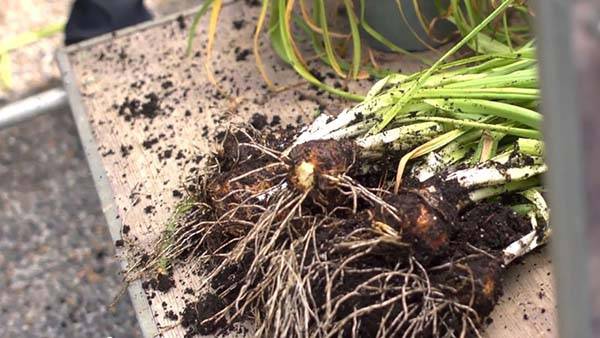

The dug out bulbs must first be cleaned of soil, inspected for damage (discarded), and then the bulbs must be treated in one of the disinfecting solutions, for example, in the same potassium permanganate or in the fungicide "Maxim Dachnik" or "Fundazol". Next, you need to dry in a shady (not in the sun!) And warm place for 10-14 days. For storage, put it in a box (you can also put it in a plastic one, the main thing is that with holes) or a cardboard box. The storage space should be cool and well ventilated, such as a cellar.


Do I need to plant daffodils


When your daffodils begin to grow, and this time comes around the third year of their constant presence in the same place. They need to be seated, and this is done so that the buds do not shrink and the daffodils do not get sick. It is better to transplant daffodils after flowering, in summer or autumn, at least once every five years. When transplanting, bulb diseases can be detected at an early stage and prevented.
To plant the daffodils and not damage the bulbs, carefully dig up the flowers along with the soil, and then divide the bulbs and plant them in new holes. It is better to dispose of sick and weak plants, you will not get lush flowering from them.
In a new place chosen for planting daffodils, dig holes, prepare a soil mixture in advance from old rotted manure, peat and sand mixed with ash and superphosphate in small quantities. Place the flower with soil in the hole and sprinkle with the prepared mixture, lightly tamping the planted plant. After planting, water the daffodils abundantly and feed with liquid fertilizers.
When to plant daffodils in autumn and spring: optimal timing
The timing of planting daffodil bulbs in the fall is determined by the weather and climatic conditions of your region of residence. It is advisable to plant flowers a month before the onset of the first frost, so that they have time to take root in a new place. At the same time, it is extremely important that by the time of disembarkation the temperature has already dropped to + 8-10 degrees and stably kept at this level for 10-14 days. Therefore, in the Central lane (Moscow region), it is optimal to plant daffodils in open ground in September. But in the Urals and Siberia, it is better to start early, already at the end of summer - in the second half of August.
Daffodils can also be planted in spring, when the soil temperature warms up to + 5-7 degrees, that is, around April-early May, depending on where you live.
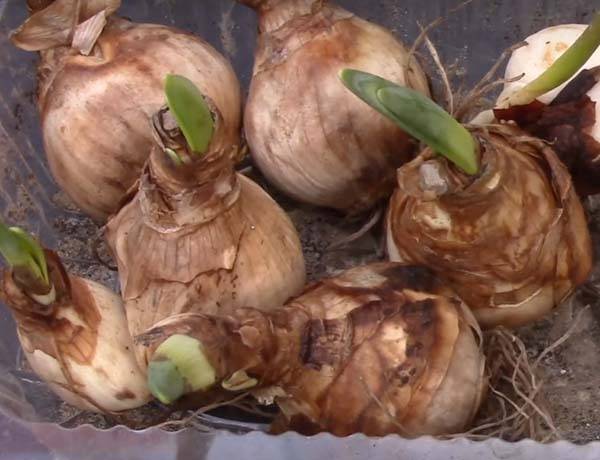

Important! If you plant daffodils in the spring, they will no longer bloom this season, so all bulbs are usually planted in the fall. Another thing is, if you were presented with bulbs or flowers driven out in a pot, then in order to preserve them, you will have to plant them in the spring. And next year they will definitely bloom.
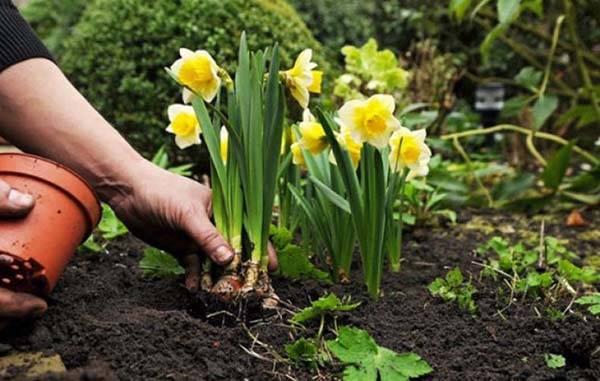

Video: how to plant daffodils in spring and what to do with them before disembarkation
How to store daffodils before planting in the fall
If you dug up daffodil bulbs in July, and you will only need to plant them in the ground in September or even in October, the question arises of how and where to store them before planting. And this question can become a problem. The fact is that narcissus bulbs are poisonous - during storage, they emit gas, from which the bulbs themselves can suffer in a room without ventilation. Therefore, put them in a box and keep somewhere in the garden under a canopy, in the shade.
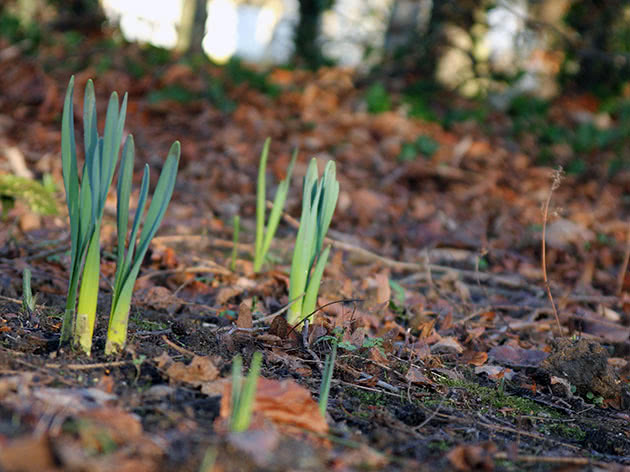

If, for some reason, you decide to postpone planting daffodils in the spring, you will have to store the bulbs throughout the winter. It is best to find a place for them in a gloomy room with a temperature of 10-12 ºC and humidity within 70%. Arrange the bulbs in a single layer on a wooden shelf or drawer and try to inspect them weekly for rot or other disease.If you find white or yellow spots on the bulbs, as well as a bad smell, immediately get rid of such planting material before the infection spreads to adjacent bulbs. Soft bulbs must also be removed.
Don't worry about the fact that daffodils can harm rodents - as already mentioned, these are poisonous flowers, and they can fend for themselves.
How to choose quality daffodil bulbs
In order to definitely not have problems with growing daffodils, you need to initially purchase high-quality planting material.
It is best to buy bulbs in late summer - early autumn, so that you can plant them right away, and not deal with their storage.
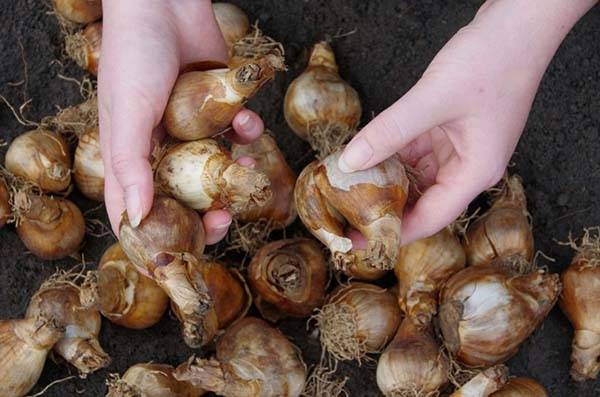

Signs of a quality daffodil bulb are:
- the presence of dry scales that have a brown or golden hue;
- dry and even bottom;
- absence of any physical damage, signs of disease, various spots and molds;
- good density to the touch;
- normal size (small bulbs = small flowers).
If a sprout has already hatched from the bulb, or it has been dug up along with a peduncle and a stem, on the lower part of which the presence of small bulbs is noticeable, then such planting material is not suitable, you should not take it.
Planting daffodils in the ground before winter
Soil for daffodils
Planting a daffodil in the fall is preceded by site selection and soil preparation, which must be carried out in the summer. Loam is most suitable for daffodils, although they grow on other soils. The optimum soil acidity for daffodils is pH 6.5-7.0. On sandy soils, the bulbs gradually become small, and then flowering ceases altogether. In addition, sandy soils freeze deeper, which can lead to the death of bulbs in winter. But if the soil in your garden is cultivated, it is not difficult to prepare it for planting daffodils.
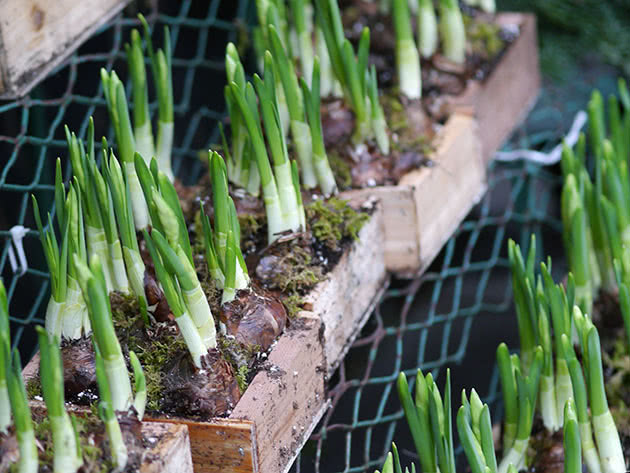

Humus and clay are introduced into sandy soil, and sand is added to heavy clay soils at the rate of 20 kg per m². Organic matter - humus, compost or rotted manure - is brought under digging to a depth of 25-30 cm at least three months before planting, that is, in spring or early summer. Humus will need about 15 kg, manure - 20 kg per m². Fresh manure can be applied to the soil no later than a year before daffodils are planted.
If you want to set aside a small area for daffodils, you can simply remove the top layer of soil in this place and replace it with special soil, bought in the store or compiled yourself.
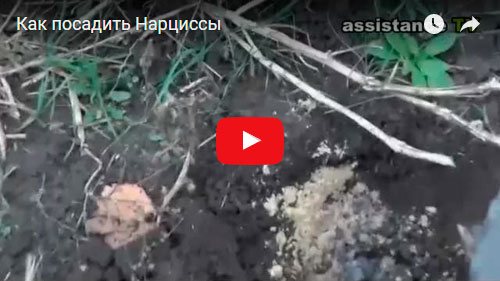

How deep to plant daffodils
When you divide the bulbous nest of daffodils, then the planting material you get is of various sizes or, as experts say, of different analyzes. Planting depth is determined by the size of the bulb, making up three heights. That is, above the bulb placed in the ground, there should be a layer of soil equal to two heights of the bulb. For large bulbs of a daffodil it is 15-20 cm, for small ones - 10-15 cm. However, there are some nuances of immersing the bulbs in the soil, allowing you to influence the flowering time and the rate of reproduction of daffodils. For example, in order for the daffodil to bloom earlier, and its bulb is overgrown with the maximum number of children, you need to plant the bulb a little smaller than the formula should be. If you want the flowers to open later and the babies do not grow as quickly, plant the bulb a little deeper than recommended. For those who are interested in the flowering of daffodils, it is better to plant the bulbs of the "extra" class, that is, large ones, and children are more suitable for the reproduction of rare varieties.


How to plant daffodils in the fall
So, in the spring you chose a sunny or semi-shady area, prepared it for daffodils, and now it's time to plant them in the ground. How to plant daffodils? Dig holes in accordance with the size of the bulbs at a distance of 15-20 cm from each other if the planting material is large, and 7-10 cm if you are planting children.Place a layer of sand at the bottom of each hole, then spread the bulbs in them with the bottom down and lightly press them into the sand to make sure there is no void under the bottom. Sprinkle each bulb with wood ash, then fill the hole with soil by half, and fill the remaining space of the hole with the same soil, but with the addition of a complex mineral fertilizer with a predominance of phosphorus and potassium in an amount half the amount required by the instructions. If the weather is not rainy, water the area abundantly.
How to plant daffodils outdoors: rules and recommendations
Daffodils will bloom richly and fragrant if you think carefully about the choice of a place and the preparation of the beds and the bulbs themselves for planting.
Seat selection
It is advisable to choose a place for growing daffodils that is well heated by the sun and relatively protected from the wind, although in light partial shade they will grow and bloom well every year. Even when choosing a site for planting, it is important to remember that low-lying places are not suitable, since due to high humidity, the bulbs can easily rot.
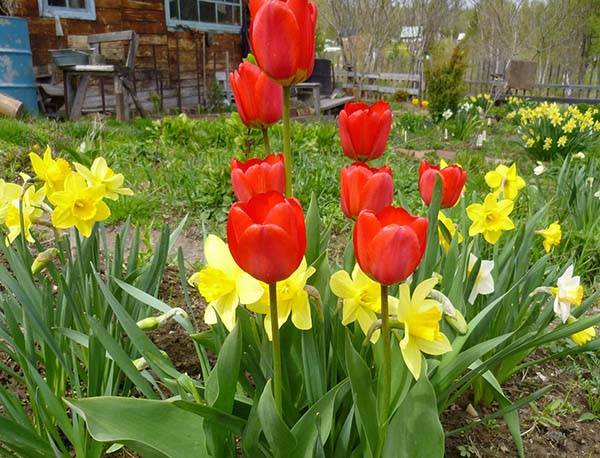

With tulips
It is beautiful to plant daffodils in a flower bed next to tulips, hyacinths and crocuses. Also, an interesting neighborhood will be with peonies.


With hyacinths
Some summer residents like to plant early flowering bulbs under trees.


Site preparation for planting
It is advisable to prepare the soil and the site for the autumn planting of any crops in advance. Ideal if it is loam.
And if you have sandy soil, then a month before planting the bulbs, the garden bed should be dug 20-25 centimeters (shovel bayonet) and added per 1 sq. m. 5 kg of peat, rotted compost or humus.
Heavy soil should be made looser with sand and humus or well-rotted compost.
Daffodils grow well in neutral soils. If your soil is acidic, then you can deoxidize it with the help of pre-ground or limestone flour or wood ash.
It will not be superfluous for digging to apply complex fertilizer - per 1 sq. m. 2 st. spoons (30-40 grams) of superphosphate.
All bulbs require drainage, unless, of course, you are planting in sandy soil. That is why it is advisable to pour a small layer of sand at the bottom of the planting pit. It must always be remembered that if the water stagnates, the bulbs will get wet and rot.
Preparing the bulbs
To avoid possible diseases, daffodil bulbs should be treated in one of the solutions before planting. For example, a solution of potassium permanganate or the drug "Maxim Dachnik" is excellent for etching bulbs, and "Fitosporin" is also suitable. In any means, the onions need to be held for an average of 20-30 minutes.


Direct landing
Step-by-step instructions for planting daffodils in open ground:
- Decide on a planting spot in your garden.
- Prepare the beds, apply the necessary fertilizers.
- Pickle the bulbs to disinfect the planting material and prevent possible diseases.
- Make planting holes. The planting depth of daffodil bulbs depends on their size and soil composition. The classic rule for planting all bulbs is that the planting depth should be 3 bulb heights. If the soil is light, then the depth can be increased by 2-3 centimeters, if it is heavy, then reduced by the same amount.
- The distance between the bulbs should be about 15-20 cm.
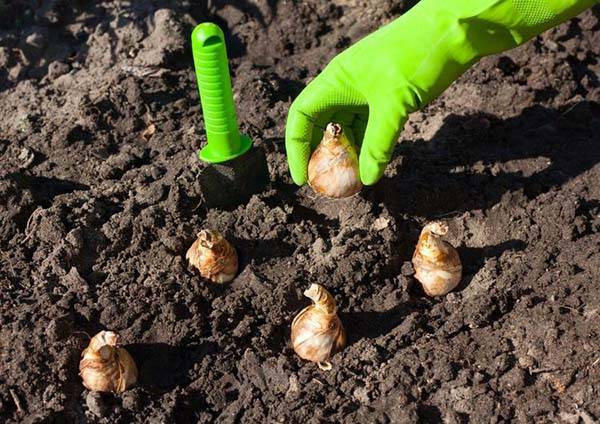

- If your soil is not light and permeable enough, then pour a small layer of sand on the bottom.
- Place the bulbs in the holes (sprouts up), and then lightly press into the sand and cover with fertile soil.
- Water it moderately.
- Mulch the planting. Sawdust, peat or the same humus are suitable as mulch. You can also use cones, thereby you will well highlight the planting site.
Video: autumn planting of daffodil bulbs in open ground
Preparing the soil for daffodils
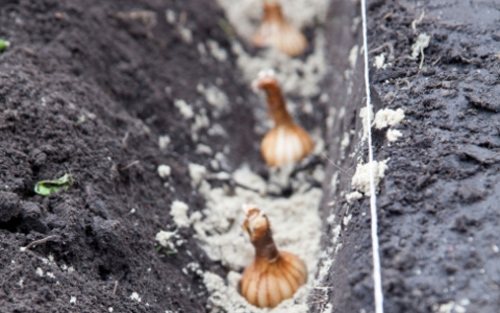

Light soils with good aeration are considered the best for planting daffodils. Loam and sandy loam soil are also suitable. However, if you see that the soil on the site is heavy, enrich it with peat bog, add half a bucket of sand per square meter, dig it up, and then level it. Additional enrichment of the soil with a mineral complex will have an excellent effect on the vegetation of plants. Do not be upset if your soil does not meet the stated requirements, it can be artificially made usable. Add sand and peat to clay soils, enrich the sandstones with chernozem and fertilizer, and move chernozem with chopped straw and river sand in a 2: 1 ratio. Too acidic soil can be limed by adding lime or wood ash.
It is very convenient to grow daffodils in high beds, for this, prepare a soil consisting of black soil, peat, river sand, add rotted manure to the mixture (namely, well-rotted manure, with an aging of about five years, because fresh humus can burn the root system of the bulb) ... Form high beds from the resulting mixture, or pour prepared soil into specially prepared ground pallets knocked down from boards. Add mineral dressing: potassium, phosphorus in a tablespoon per square meter of soil, mix, level.


It is better to plant bulbs from August to October; you must calculate the exact time of planting yourself, since it will depend on your climatic latitudes. It takes a month for a daffodil to take root well, so this must also be taken into account when planting the bulb. The root system of the flower should anchor well enough in the ground, before the onset of frost.
Outdoor daffodil care
If you take proper care of the daffodils, these wonderful blooms will grow well and delight you with abundant flowering. To do this, you only need to follow the standard care recommendations: water moderately, feed regularly, weed and loosen if necessary.
Daffodils love watering, especially in early spring, during the period of the beginning of growth and formation of green mass, budding and flowering, as well as at the end of it (it is at this time that the bulb is stocked with food).
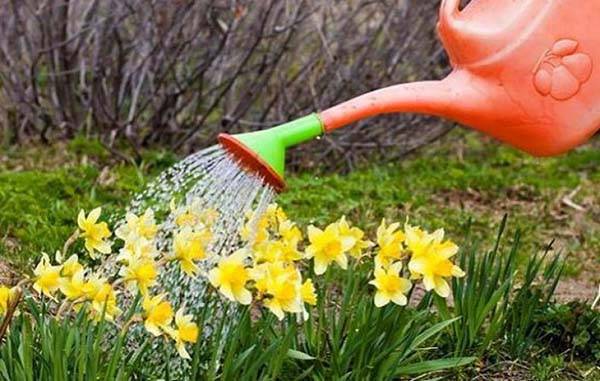

For better flowering, daffodils should be fed several times:
- In early spring, when the first greens appear, ammonium nitrate or nitrophos or some other nitrogen fertilizer. You can also make a green fertilizer (herbal infusion).


- During the period of bud formation - potassium-phosphorus fertilizer.
- During the flowering period - also a fertilizer with a high content of potassium and phosphorus.
- After flowering, it is recommended to apply phosphorus fertilization. Superphosphate is ideal.


Note! In order not to burn the root system of the plant, it is advisable to water it before feeding.
So that the plant does not waste its energy senselessly, its fading buds (future seed boxes) should be removed in time. And then you can beautifully weave braids from the remaining leaves (they cannot be cut off, through them the bulbs accumulate nutrients).
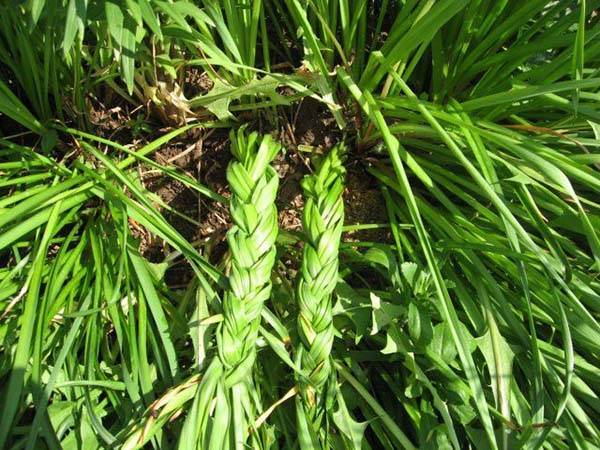

Video: what to do with daffodils after flowering
Digging the bulbs
Daffodil bulbs should be dug out at least once every 5-6 years, although, for example, the same tulips - once every 3 years. It is possible and more often, but if you accidentally damage them a little, then there will be a very high probability of the disease. In other words, these bulbs do not like to be touched and transplanted once again, however, this must be done once every 6 years, otherwise the flowers are too crushed and become simply ugly.
When to dig up daffodil bulbs?
The main signal for digging is yellowing of the tips of the leaves (the bush becomes lethargic, and the leaves begin to fall on the ground). As a rule, this occurs on average a little less than 1.5-2 months after flowering (that is, in May-June).If you are late, the flowers can take root, which will be very easy to damage when digging up.
Advice! In order not to damage the bulbs, dig them out using a special miniature garden fork or a shovel, but very, very carefully.
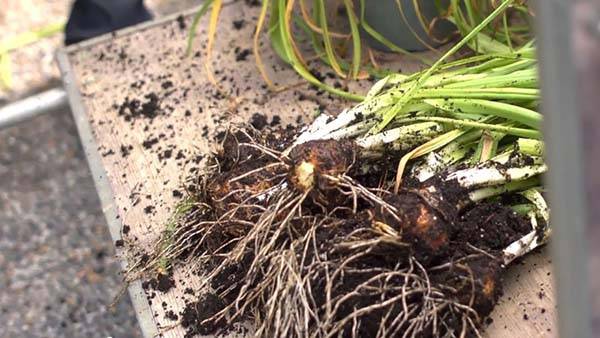

The dug out bulbs must first be cleaned of soil, inspected for damage (discarded), and then the bulbs must be treated in one of the disinfecting solutions, for example, in the same potassium permanganate or in the fungicide "Maxim Dachnik" or "Fundazol". Next, you need to dry in a shady (not in the sun!) And warm place for 10-14 days. For storage, put it in a box (you can also put it in a plastic one, the main thing is that with holes) or a cardboard box. The storage space should be cool and well ventilated, such as a cellar.


Digging up daffodils for storage
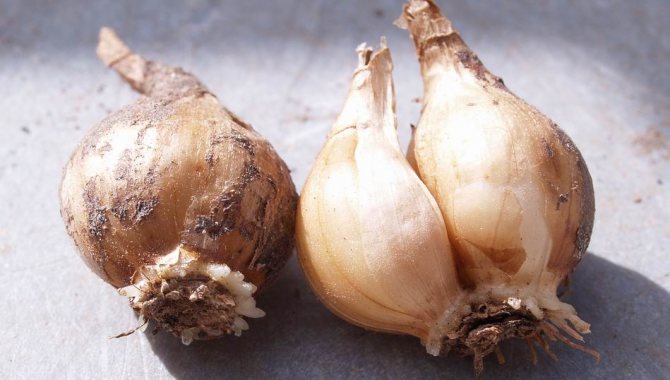

At the end of flowering, the gardener faces the question of digging out the bulbs for storage and transplanting, or the implementation of its preservation in the ground. Experienced gardeners say that capricious varieties of daffodils do not tolerate well when they are disturbed more than once every three years. Plants start to get sick and refuse to bloom. However, what about those varieties that grow too quickly? Or those varieties that do not give the desired reproductive result and are prone to frequent diseases? For this, daffodil bulbs are harvested. Digging them up, drying and treating them with fungicidal preparations will quite cope with dangerous diseases. And the manipulations aimed at stimulating reproduction made with the bulb during storage will force it to give babies.


So, digging is done after flowering, when the ground part of the plant dries up. Clean the dug out bulbs from the soil, dry in a well-ventilated room, without exposure to sunlight, sort and separate the children. Antiparasitic and fungicidal treatment is mandatory. Then the bulbs are dried again and stored in a darkened room at a temperature not higher than 17 degrees, until the next planting in open ground.
If you do not intend to dig up daffodils, and decide to leave them in the soil, provide them with watering. Remove dried stems and leaves. Organize weeding and provide aeration to the plants, add top dressing, because after flowering, the bulb will begin to form babies. There should be no weeds in your flower bed, their root system can harm the formation of children. For the winter, cover the flowers with a 15 cm layer of mulch.
How to plant daffodils outdoors
Choosing a place to plant daffodils and properly preparing the soil are important factors affecting the growth and development of plants.
Proper site preparation for daffodil planting
For this type of bulbous, a sufficiently illuminated place without drafts is suitable. Daffodils feel good in partial shade, but they should not be planted under tall trees or next to buildings. An overly lit area, where the sun beats down from morning to evening, will not suit them either. The only exception will be some light-loving varieties. It is better to choose a place in the country in a light shade so that they bloom longer and the color is richer.
Daffodils will withstand a short flooding by melt water, but they will not be able to live in such soil permanently, since the bulbs will simply rot. To prepare a flower bed or garden bed, you need to remove 30-40 cm of soil and pour drainage into the resulting hole. For this, the following are perfect:
- pebbles;
- expanded clay;
- crushed stone;
- vermiculite.
From above, 8-10 cm of sand is poured onto the drainage, then - nutritious soil. The flower bed must have a drainage in the form of ditches and be above ground level. It is advisable to overlay it with a border made of natural stone or artificial materials.
What soil is needed for planting
If sandy soil prevails on the garden plot, it is made heavier by mixing with clay. Sour needs liming. For this, 300 g of slaked lime is applied per 1 m² one year before planting.
The most fertile soil for daffodils is loamy, although they can be easily grown in black soil and peat. The main thing is that the acidity indicators are close to neutral (pH 6.5-7).
If you add about 400 g of lime to 1 m², the acidity of the soil will increase by 1 pH unit.
The first digging of land for daffodils is carried out in advance, in July. At the same time, about 15 kg of humus is introduced per 1 m². The second time the garden bed is dug up 2-3 weeks before planting and fertilized with phosphorus and potassium (50 g of superphosphate and 30 g of potassium chloride with sylvinite (potassium salt) per 1 m²).
Where are the best places in the flowerbed
Landscape designers often decorate alpine slides, alleys, curbs with daffodils and tulips. It is also practiced planting bulbs in a perennial flower bed next to peonies, pansies and early flowering shrubs (hazel and wolfberry).
Landing features
Planting in the fall requires adherence to special technologies. The bulb must be planted in the soil that has already been prepared, in the holes of the required size, and the flower must be fed with special fertilizers.
Seat selection
A very important factor for the good growth of daffodils is the place where they are planted. For flowers of this type, and especially those with pink and orange crowns, it is very important that the place is semi-shaded, since the buds easily fade in the sun. Daffodils are also very fond of flat areas of land that are closed from the effects of the wind.
According to the observation of many gardeners, daffodils growing in places protected from gusts of wind delight their owners with longer flowering. They will feel good growing near deciduous trees. But among the large plantations of shrubs and trees, they will not be comfortable. If other plants set off daffodils, then the aroma of flowers will become less intense, and the flowers will be smaller.
The location of groundwater can also greatly affect the condition of the bulbs. For their comfortable growth, it is necessary that the groundwater is no higher than 60 cm from the surface. Areas subject to frequent flooding due to rain or melting snow are categorically unsuitable for landing.
Important! In such conditions, fungus spreads, which can cause rotting and death of flowers.
Soil for daffodils
The most preferred soil for daffodils is loam. The acidity should be between 6-7.5 pH. In order for these plants to grow and bloom well, you should not use sandy soil. Most likely, even in such unfavorable soil, for some period daffodils will throw out good buds and delight with aroma. But this is only due to the supply of previously prepared nutrients, as well as macro and micronutrients.
Preparing the soil for planting
As the supply of these substances is depleted, daffodils may stop flowering and their bulb will become smaller. In especially unfavorable soil, they will die altogether. Therefore, the land in the garden where flowering plants will grow must be appropriate, then there will be no problems with daffodils.
In order to prepare the place where the bulbs will be planted, first you need to clean up - throw away all the pebbles, various debris, the roots of other plants and other objects. Then you need to analyze the soil itself:
- for heavy, clayey, it is recommended to add a little sand, about 20 kg / sq. m;
- sandy soil is recommended to be diluted with clay and peat or use humus.
If soil fertilization is required, this is done no later than 2-3 months before the bulbs are planted. If fresh manure is used as top dressing, then daffodils can be planted no less than a year later. The best time to fertilize the soil before planting daffodils is early to mid-summer. The specified period can be moved taking into account the climatic zone and the planned planting time.It is allowed to introduce 15-20 kg of rotted manure or humus per 1 sq. meter of earth.
Note! It is important to be responsible when applying fertilizers such as fresh manure. In no case should it be used before planting, since the compounds it contains are capable of burning young bulbs.
Daffodils need fertilizing with mineral fertilizers. In the first year, they will use their own reserves, so there will be no need to use such resources from outside. When planting daffodils in the fall, feeding should be done no earlier than the first flowers appear, and this can take from 4 to 6 months. After the flowers go through the flowering stage, they will need macro- and microelements, which they can get from mineral fertilizers.
Daffodils often need phosphorus and potassium. Both of these elements are very important, and each of them is responsible for performing specific functions. Phosphorus provides flowering and bulb formation. It depends on him what size the flower will be and how intense its aroma will be. Potassium is responsible for the normal synthesis of starch and sucrose.
Important! As for such an element as nitrogen, then you should be careful with it, since in an acceptable dosage it helps in the development of flower tissues and promotes its growth, but to a greater extent - it can have a rather detrimental effect on plants.
Planting daffodils
Planting and caring for daffodils includes a number of mandatory rules, neglecting which, you should not hope for a positive result. In order for a flower to grow healthy and strong, you need to observe planting dates, know the depth and distance between plants, and choose high-quality bulbs.
How to choose healthy daffodil bulbs for planting
Planting and caring for daffodils will not be difficult if you initially select good planting material. The bulbs should be firm, with a dry neck and bottom. The scales are brown or golden, with no signs of decay, dark spots or plaque.
In addition, you need to know what to treat before planting to prevent fusarium and gray rot. The simplest and most effective is a weak solution of potassium permanganate.
What depth to plant
Many are wondering how deep to lay the bulbs so that they do not freeze and germinate in the spring without much difficulty. This parameter directly depends on their size and is equal to three diameters, on average - 12-15 cm. If the soil is loose and light, it is planted deeper, if the soil is heavy clay, it is closer to the surface.
In Latvia, gardeners put small unsalted sprat or capelin under their bulbs, which is an excellent source of potassium and phosphorus.
Forcing daffodil bulbs is a guarantee of flowering
For forcing, daffodils with large and heavy bulbs are best suited. They are soaked in warm water at a temperature of 40-45 ° C for 4 hours. Then they are planted in prepared containers or wooden boxes so that 1-2 cm remain above the surface. The soil between the bulbs is covered with sand and watered well. The containers are sent to a cool place (10-12 ° C) for 3 months.
With the appearance of sprouts 10-15 cm long, they are transferred to heat and looked after like other indoor plants. Buds will appear 2-3 weeks after distillation.
To get flowers on the eve of March 8, you need to start forcing in mid-October.
When to plant a daffodil
Planting daffodils in open ground is carried out mainly in the fall, so that the bulbs take root well and form flower buds. A number of flowers have their own special life cycle, when the root system is actively developing just after the end of the warm season. Narcissists are a prime example of this. The ideal time for this would be mid-August - early September, adjusted for the climatic conditions of the region. In the spring, planting daffodils is possible only if the dates for the autumn planting were missed for a number of reasons.This is best done right after the snow melts, around mid-April. There is no need to delay with planting, since late planted plants will develop more slowly and it will take a year or two to wait for them to bloom.
Landing Scheme, or Starting with a Plan
In most cases, daffodils are not planted en masse, since after flowering such a flower bed will lose its decorative appearance due to yellowed drooping foliage. The classic layout is small islets of 5-7 plants, surrounded by perennials (hosts, geraniums, cuffs). The early varieties of daffodils look interesting in the company of chionodoxes, crocuses, snowdrops, the later ones - with primrose, incense, tenacious.
The landing pattern can be represented in three ways:
- The bulbs are planted in rows at a distance of 15 cm from each other, row spacing - 20-25 cm.
- The holes are dug in a checkerboard pattern of 15 x 15 cm, this method is called square-nested.
- They make a wide hole and put several onions there at once.
Planting daffodils correctly
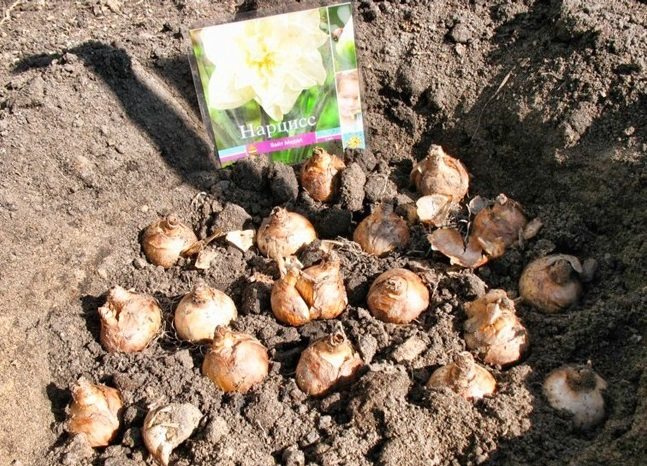

In order to properly approach the planting of flowers, first you need to determine the type of your soil on the site, take into account the size of the bulbs themselves. The bulbs are planted to a depth of 13 centimeters (heavy soils, warm climate) and up to (26 centimeters, light soils, cold climates). Plant the bulbs in such a way that freezing of the soil does not touch them, and the groundwater does not wash away the root system. Therefore, it is so important, when planting, to take into account all the positive and negative factors in the complex. Leave the distance between the rows about half a meter, for convenience when caring for plantings. To get large children, daffodils are planted at a closer distance to each other, and at a smaller embedment in the ground.
To prevent your flowers from freezing, the soil after planting can be mulched using peat mixed with humus and straw. And when the first frosts come, the flowerbed with plantings can additionally be covered with straw or dry grass, but in early spring, the mulch is removed so that the plant can start growing without obstacles.
Narcissus: care and cultivation
Narcissus is an unassuming and grateful flower. Provide him with minimal care, and he will delight with flowering annually. In one place, daffodils grow well for 5-6 years.
Spring feeding - vitamin cocktail for a flower
In the spring, daffodils are fed with ammonium nitrate. This nitrogen fertilizer has a beneficial effect on all processes in the life of a plant, especially on the growth of green mass. Phosphorus and potassium are added before flowering - this contributes to the formation of buds and active reproduction of bulbs.
The best varieties for outdoor cultivation
There are more than 25 thousand varieties of daffodils, which form several main groups:
- tubular;
- terry;
- triander;
- small-crowned;
- large-crowned;
- split-crown;
- bell-shaped;
- Jonquill's daffodils;
- cyclamen;
- multi-flowered;
- poetic;
- wild.
For open ground, different varieties have been bred, differing both in the shape of the flower and in size. The best are “maximus”, “king alfred”, “birshiba”, “kantara”, “spring glory”, “fortune”, “ivs”, “damson”, “killigrew”, “gret warley”, “mary copland”, Sunrise.
Many of them are suitable for early forcing and can grow beautifully in a pot. When choosing a planting material, you need to carefully read the description of the variety.
What to plant nearby, or Good neighbors
When planning a flower bed, it is necessary to take into account not only the aesthetic aspect, but also the possible symbiosis of plants. So, next to tulips and daffodils in a flower bed, it is useful to sow crops that scare off flies, such as:
- calendula;
- marigold;
- nasturtium;
- white mustard.
Such a neighborhood will not only look interesting, but will also protect the flowers from the daffodil hoverfly.
When to plant overgrown daffodils
Daffodil bulbs begin to form daughter, smaller bulbs for 3-4 years.It makes sense to pinch them off the mother plant and plant them separately for growing, the planting depth is slightly less than usual.
You can also propagate a daffodil by dividing the bulb itself. For these purposes, choose the strongest, well-dried. Cut with a sharp blade into several segments with a part of the bottom, after removing the top. Further, the fragments of the onion are disinfected in a weak solution of potassium permanganate and placed in peat for 3-4 months. The substrate temperature should be between 17-20 ° C. During storage, the buds will wake up and give new shoots. After that, they are transplanted into small containers, for example, into plastic bottles. The soil is made up of peat and river sand (3: 1), the containers are placed in the basement before spring disembarkation in a permanent place.
Proper watering and loosening
It is necessary to water the daffodils as the soil dries out; a lack of moisture in the soil should not be allowed. To shed soil to the desired depth, you need 2-3 buckets per 1 m².
Like other crops, daffodils should not be watered in the middle of the day, the best time for this is 6-7 pm. The water should be kept warm.
Daffodils are especially sensitive to water shortages after they have faded. The foliage does not wither for another 30-40 days, and at this moment vital substances accumulate in it, which are subsequently stored in the scales of the bulb.
Watering is stopped when the ground part of the plant withers. In the Moscow region and central Russia, this is the beginning of July, in Siberia and the Urals - a little later. Weeding and loosening is an important part of the maintenance of this beautiful flower. It is advisable to loosen the soil after each watering, prolonged rain or fertilization, the depth is 3-5 cm.
Fertilizing daffodils
In areas not characterized by high fertility, daffodils are fed several times per season. The first time fertilizers are applied during the period of mass shoots, the second - at the beginning of budding, the third - at the height of flowering. To do this, use a nitroammophoska at the rate of 70 g per 1 m². After flowering, the soil is fertilized with superphosphate (40 g / 1 m²) and potassium sulfate (20 g / 1 m²). On fertile soils, the dose is reduced by 2-3 times, guided by a good rule: "It is better to underfeed than overfeed." Fresh manure can be applied at least one year before planting the bulbs, otherwise the adventitious roots can be burned.
Transplanting daffodils to another location
In one place, the daffodil grows up to five years, but then its bulb must be removed from the soil, the children must be separated from it and planted. Sometimes this needs to be done once every five years, and sometimes more often, because the growth and development of plants depends on many factors. However, experts say that it is not worth dividing the bulb earlier than three years later. If you notice that your daffodils are overgrown and begin to bloom worse, these are sure signs that it is time to replant them. When to transplant daffodils - in the spring or in the fall? It is more correct to do this after the daffodils have faded. But not immediately, but only when the leaves of the flowers turn yellow and fall, and this happens to daffodils closer to the middle of summer.
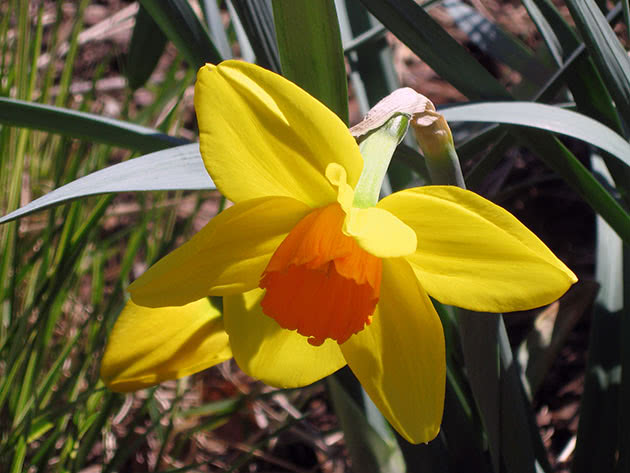

As soon as the compact daffodil bushes begin to disintegrate, remove the bulbs from the ground with a small fork, trim off the remaining stems and leaves from them and place in a dark, dry place to dry. When the bulbs are dry, clean off the earth from them, carefully separate only those children that easily walk away on their own, discard sick, deformed, soft or diseased bulbs, and rinse high-quality ones under running water, pickle for 10-15 minutes in a strong solution of potassium permanganate dark pink and put back to dry in a dry, dark place with a temperature not exceeding 25 ºC and good ventilation, and then store.
When to transplant daffodils in the fall? August to October. The transplant is carried out in the order already described by us on the site prepared in advance. You also know how to cultivate the soil for daffodils.
Seed propagation: how you can breed a new variety
It makes sense to grow daffodils from seeds only for the sake of breeding a new variety. Seedlings bloom for 4-5 years, therefore, this method is used extremely rarely among ordinary florists. Another thing is breeders who plant daffodils in huge areas in the hope that at least one will be interesting for further work and consolidation of the variety.
Freshly harvested, well-ripened seeds are suitable for sowing. They are placed in an earthen mixture a few centimeters deep and kept at a moderate temperature until the onions grow. After that, the seedlings can be transferred to open ground. Seedlings from hybrid seeds do not inherit the characteristics of the parent plant.
Self-breeding daffodils
Reproduction of daffodils by seeds
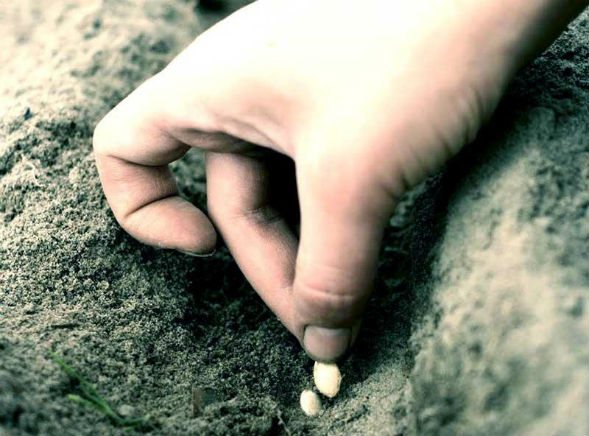

Daffodils are bulbous plants that multiply in several ways, the main ones are vegetative and seed. The latter method is actively used by breeders to obtain new varieties of plants. For this, bulbs of different varieties are subjected to artificial pollination at the time of flowering to obtain a new hybrid. The seeds obtained in this way are sown in specially prepared containers and placed in a room with a temperature of at least 20 degrees, gradually, after two weeks, the temperature is reduced to 15 degrees. A bulb from seedlings begins to develop only in the second third year of life, therefore the process of reproduction by seeds is very laborious and long.
Vegetative breeding method for daffodils


This method of reproduction is quite often used by gardeners, since with minimal labor costs, by the second year the mother bulb will give full-fledged children, ready for planting in open ground and independent existence. Depending on the variety, one bulb can give up to four babies, which will be ready for separation in the second third year. To artificially force the onion to begin dividing, it is dug up and not cut too deeply, stored in a cool, well-ventilated room. After two or three months, the bulb will give new babies, and it can be planted in the ground with them, and in the second year, new bulbs can be separated and planted on their own.
Reproduction using paired scales
This type of reproduction involves the selection of large bulbs, drying them, then cleaning from scales and roots. After, with a knife, it is necessary to divide the onion into six, eight parts, soak it in a fungicidal solution, dry it. Select paired scales and pack in a bag with perlite and maintain the incubation temperature at +21 degrees. In four months, if the operation to divide the scales was carried out correctly, the formation of new baby bulbs will begin. In autumn, when the formation of young bulbs is over, they can be separated from the scales and planted from pots, and when the bulbs grow up, planted in open ground.
Major diseases and pests
Growing daffodils in the open field can be complicated if the plants develop any disease. This is often the result of improper agricultural practices. Most often, daffodils affect diseases such as:
- fusarium;
- ring spot;
- gray rot (botrytosis);
- sclerocial rot;
- penicillous rot;
- bacterial scab.
All bulbs are susceptible to viral diseases that can penetrate the soil, through insects (aphids, thrips) or when processing plants with an infected tool. Prevention is the timely culling and destruction of infected bushes.
The most common daffodil pests are:
- click beetles;
- onion hoverfly;
- onion root mite;
- cabbage scoop;
- common bear;
- nematode;
- slugs.
Growing daffodils in a pot
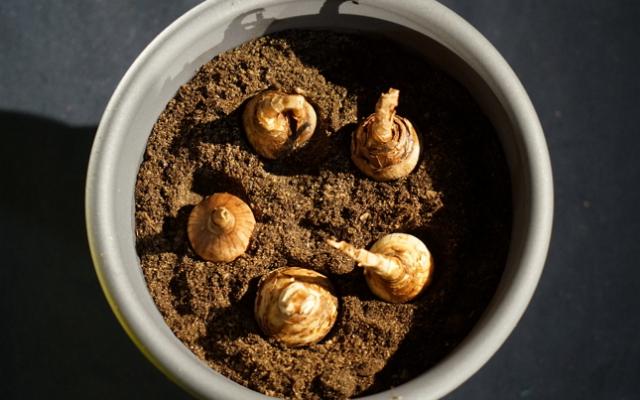

Daffodils can be grown not only in the open field, but also in pots, but also on your windowsill. To do this, you need to select plant bulbs that have proven themselves well.It is better to choose late-flowering varieties, as they will grow faster at room temperature. The bulb should be heavy and healthy.
For planting, a pot or other adapted container is prepared, which is filled with soil up to half, then the bulb is placed, so that the top shows from the soil by a third. Then the soil must be lightly tamped and watered. Then the containers with the planted bulbs are placed in a cool place or buried in the ground until sprouts appear. When the plant begins to sprout, the pots are brought into a well-lit room, avoiding direct sunlight on the flowers. The formation of a bud should be accompanied by an increase in temperature to +16 degrees.
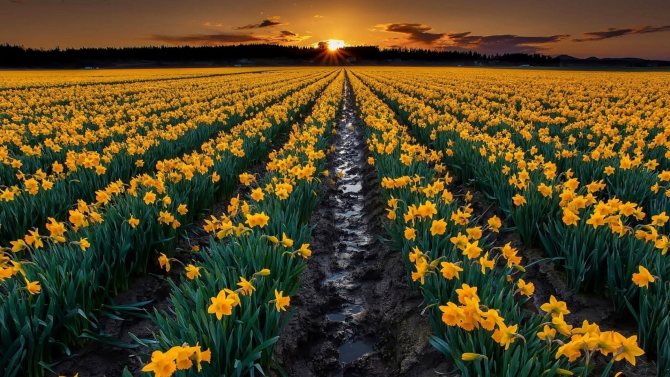

Do not forget about caring for your plantings. Water the daffodils regularly, feed them. When the daffodil grows up, you should also take care of the stability of the pot. Thus, the flowering of daffodils can be observed on your own windowsill. After the flowers have faded, trim off the wilted leaves and continue watering so the bulb can finish its vegetative cycle with babies. After the bulb is dug out, dried, and another should be chosen in its place so that it blooms annually. Because last year's bulb is not suitable for re-forcing daffodils, but in the open field. It is capable of flowering and its normal growing cycle.
What to do to make daffodils bloom every year
By observing a few simple rules, you can achieve an annual abundant and long-lasting flowering of daffodils:
- Pruning of the ground part is done only after the leaves have completely wilted (they should turn yellow and lose their elasticity).
- You do not need to dig up the bulbs every year, let the plants stay in one place for 3-4 years.
- When grown in poor soil, daffodils need to be fed regularly. Without this, the plants may look healthy and strong, but will not bloom.
Useful tips for florists
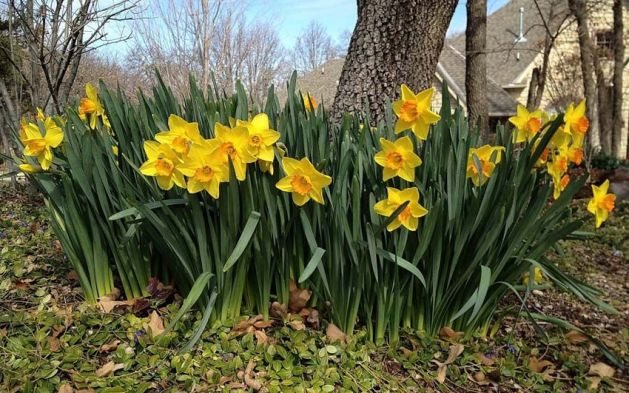

For those who decided to plant daffodils on their site, but have never done this before, the recommendations of experienced florists will come in handy:
- Although these flowers are considered an unpretentious crop that can grow even in poor soil, it is better to give them periodic feeding for quality flowering. Otherwise, the result of growing vibrant spring daffodils may not live up to your expectations.
- Wait until the leaves turn yellow before digging up the bulbs and storing them. After all, it is they who supply the bulb with nutrients, in the process of withering, redistributing the reserves of valuable minerals to the underground part of the plant.
- If the planting material was purchased late, it will be necessary to insulate the flower bed with mulch after planting, since the tubers will not have enough time for full adaptation.
- Even those species of daffodils that do not need an annual transplant need to be dug out of the ground every 4-5 years. This will improve the quality of the bulbs themselves and flowering, and help the plants resist various diseases.
Grooming without fanaticism - mistakes in caring for daffodils
Many novice growers violate the timing of planting bulbs, neglecting the peculiarities of the life cycle of a daffodil. Untimely planting threatens the lack of flowering and even the death of the plant. The same goes for fertilization. An excess of nitrogen in the soil as a result of inept feeding with urea or ammonium nitrate promises a rapid build-up of green mass and poor flowering. You should also not neglect the storage of planting material in the refrigerator. Planting daffodils and care in the open field is not difficult, the main thing is to choose the right time for pruning and replanting, do not forget to water, fertilize and loosen the soil. In response, daffodils will delight you with long lush flowering and present a delicate delicate aroma. It is not for nothing that the name Narcissus Poeticus, translated from Greek, means "intoxicating and stunning."
Planting care
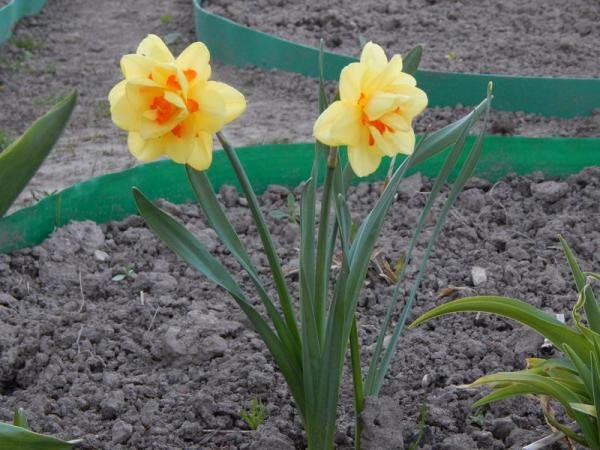

To prevent the germination of bulbs after planting in the event of a weather anomaly, the surface of the flower bed must be covered with sawdust, peat or leaf litter. It is allowed to use a mixture of the listed components. The thickness of the mulching layer should be 2-5 cm. If the sprouts appear in the fall, they will freeze in winter, and there will be no spring flowering.
Some summer residents mistakenly believe that after planting, daffodils do not require care, but this is not entirely true. For successful rooting, tubers need moisture. If the fall is rainy, watering can be skipped. In dry weather, it is recommended to water the flower bed within the next 2-3 weeks after planting the planting material, the soil should not look dry.
During prolonged rains over the plantings, it is necessary to build a shelter made of film so that the earth does not turn into a swamp and the bulbs do not rot. If there is a little rain from time to time, the soil should be loosened regularly.
Preparing the site


Daffodil bulbs before planting
It is necessary to prepare the soil for planting daffodils in the second month of summer. You should choose an area with flat ground, well-lit by the sun. Daffodils with bright orange or pinkish crowns should be grown in partial shade to maintain their rich color. It is important to note that places where rainwater accumulates and snow melts are not suitable for keeping these flowers: groundwater must lie at least 60 cm.
Heavy soil and soil that cools quickly should be avoided: they are poor in nutrients and hardly allow water to pass to the rhizome of the fragile and beautiful daffodil. The soil should be fertilized with humus and clay two to three months before planting. Organic matter is introduced by digging at 25-30 cm. Mineral fertilizers are added to the soil directly during planting, and it is contraindicated to apply manure in the first year of growth.
How to choose the right place and soil?
When choosing a place and soil for planting daffodils, give preference to well-lit places. It has been noticed that properly planted in an open, sunny space, flowers bloom longer and have larger buds. But even a light shade will not prevent daffodils from growing beautiful and fragrant.
You can plant other flowers next to these plants, and then after they wilt, there will be no bald spots in the flower bed.
The following composition will look nice:
- crocuses (they bloom in early spring);
- daffodils (flowering in May);
- flaxseed, nasturtium, calendula or other annuals (their flowering time is June - September);
- pansies (bloom from May to snow);
- asters, dahlias (they bloom until the very frost).
If you decide to plant daffodils at home, then immediately after planting, keep the pots of bulbs in the dark and cool. And after the sprouts appear, transfer them to a warm and well-lit room.
Since flowers love moisture, you should carefully consider the choice of soil. If it is sandy, add clay or peat before planting. The acidic soil must be enriched with ash. If there is a lot of clay in the soil, then when planting the bulbs on the bottom of the hole, pour 3-4 cm of sand, make a drainage layer.
You can also fertilize the selected area with humus. Only this should be done 2 years before planting and it is better to take rotted bird manure (you can always buy it at a flower shop). The high concentration of nitrogen, potassium and methane in fresh organic fertilizer can simply burn the bulbs.
For indoor growing, choose the recommended substrate or prepare it yourself from garden soil, sand and sawdust, mixing the components in a 2: 1: 1 ratio, respectively.
Particular attention should be paid to choosing a pot in which daffodils will grow. It should be ceramic, no higher than 15 cm and up to 12 cm in diameter. A drainage hole is required. Too large a pot will delay the flowering period, or even no flowers at all.
For those plants that you plan to transplant outdoors, the size of the pot is not important.The main thing is that the onions are not cramped, and they do not stick together.
Cleaning the bulbs for storage
The bulbs should be removed for storage after the leaves begin to fall and turn slightly yellow at the tips. If you keep the plants in the ground until the leaves are completely dry, then when digging up you may not see the bulbs and damage them. Also, their long stay in the ground provokes the development of new roots. There is a risk that the roots will be damaged during further harvesting, sorting and storage. And such bulbs take a long time to recover and may not give the expected flowering.
The excavated planting material should be carefully examined. Separate rotten, soft (even if there is no visible damage on them) and diseased bulbs. Such specimens should be burned away from the site, and healthy ones should be treated with a solution of potassium permanganate, dried and left to winter in a box with good ventilation away from rodents.
No need to store planting material in bags. A greenhouse effect is created, which will provoke the death of the bulbs.
Potted daffodils should also have their leaves trimmed after flowering when they are completely withered. Move the pot itself to a dark, cool place (the bulbs remaining in the ground will be comfortable on the bottom shelf of the refrigerator). The bulbs can be removed from the ground, examined for signs of illness, wrapped in paper and stored in a dark place.
Meet daffodils


The name "narcissus" comes from the Greek word for "intoxicate." The Greeks gave this name to the plant due to its amazing smell, which is able to enchant any person. Despite the harsh scent of the plant, it looks fragile and delicate: the bright yellow core is framed by a fan of delicate white petals. The peduncle of the plant reaches 40-50 cm, and the leaves of the daffodil resemble green ribbons, directed upward, or slightly inclined.
Narcissus loves shade. Propagated by plants or shoots. If there are fewer flowering shoots, the plant should be transplanted. Dried leaves should be removed and bulbs should be dug up.
It is necessary to plant a daffodil in the fall precisely so that it has time to take root in the soil and bloom effectively in the spring. In this regard, planting is relevant in late August and early September.
Narcissus is so beautiful that legends are made about him. Probably, many people know the legend about a young man named Narcissus, who was forbidden to look in the mirrors. Once the young man could not resist the temptation and looked at the smooth surface of the water, in which his reflection could be seen. He was amazed at his own beauty, stared at his reflection for a very long time, and eventually turned into a daffodil.
What can you plant daffodils with?
When growing a crop, be sure to plan well the location of the daffodils in the flower bed. Not all plants are capable of neutralizing this species, and in some cases, joint growth with certain species nearby can contribute to the inhibition of each other's growth.
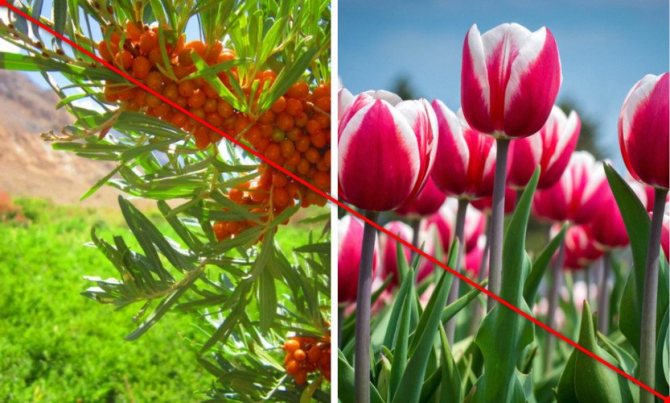

To avoid this, it is not recommended to plant daffodils next to sea buckthorn and tulip. In addition, it is not recommended to plant all kinds of daffodil hybrids nearby. This will lead to cross-pollination and a joint loss of valuable varietal traits.
Also learn how to use tulips and daffodils in landscaping.
In this case, it is recommended to plant a flower near crops with increased aromatic properties. This will help scare off the onion fly - the main pest of all bulbous plants and representatives of the Amaryllis family.
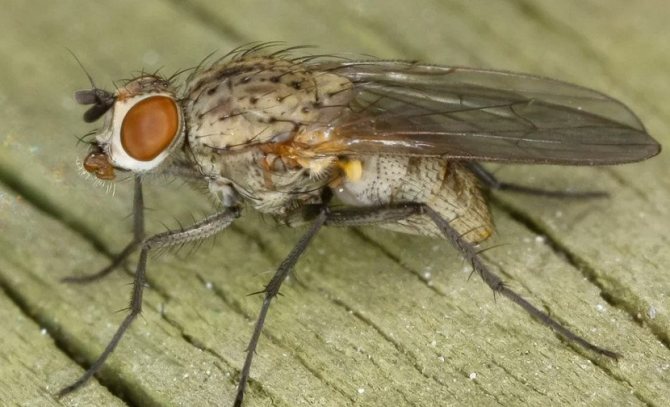

These include:
- white mustard;
- nasturtium;
- calendula;
- marigold.


Preparing for winter
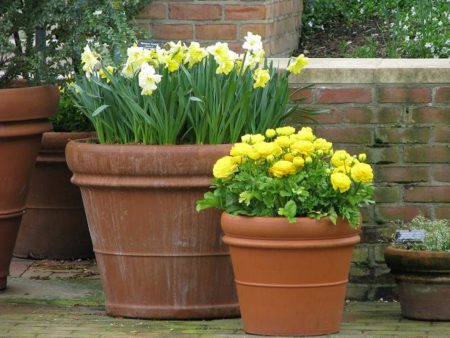

Daffodils, although they have good frost resistance, require shelter for the winter. Before the onset of severe frost, lay a layer of mulch on the flower bed. Rotten humus, peat, sawdust, straw, leaves are suitable as mulch. The more severe and earlier winter comes to the region, the thicker the mulch layer will be. For Siberia and the Urals, immediately before the cold weather, cover the flower bed with spunbond or lutrasil.Do not cover the plants with a film, it prevents air from entering, a greenhouse effect forms under it over time: the bulb will simply rot in the ground. If in your area the temperature in winter does not drop below -20 degrees, then ordinary snow will hide the flowers in the ground from frost. It is only necessary to cover the flower bed with special material for regions with a harsh climate.
Attention!
If you cover daffodils with spunbond for the winter in the suburbs, they will not germinate even in winter, much earlier than the due date.
Major mistakes
Below are the most common mistakes associated with planting and growing daffodils, familiarization with them will help prevent their recurrence in the future:
- Violation of the timing of not only planting, but also digging out the bulbs. What is dangerous too early or, conversely, late landing, has already been mentioned in the article. At the same time, digging out the tubers while the plant still has green foliage is another rather gross mistake, since at this time the process associated with the accumulation of nutrients in the bulbs is actively underway. Dig them out of the ground is allowed only after all the leaves turn yellow.
- Bulbs should not be exposed to direct sunlight for a long time at any stage. Daffodil tubers are already prone to dangerous drying out, and the situation described can lead to burns.
- Planting bulbs in spring without refrigeration. Keeping planting material in a refrigerator or other cool place is not only a recommendation, but a mandatory requirement, since if it is not observed, the plant will grow weak and be susceptible to various diseases.
What to do if daffodils have sprouted
Situations when daffodils have time to germinate in the fall are not uncommon, usually for the following reasons:
- Landing region, differs in too mild climatic conditions or in a particular year it was just a rather warm autumn.
- Violation of landing dates was recorded, and its implementation even before the beginning or mid-August.
- The onset of a long and strong thaw in the middle or late autumn.
Today, weather anomalies are observed very often, so the gardener should know how to react to the autumn germination of daffodils, because this requires him to take additional actions:
- Initially, additional soil mulching is required, for this you can use peat, sawdust and dry fallen leaves. Mixing of the named components in equal proportions is allowed. The layer thickness can be from 2 to 5 cm, depending on the height of the sprout.
- It may be necessary to create an additional insulating shelter. These measures, as well as mulching, should be carried out after a stable cold snap, when thaws are no longer expected. At the same time, you need to have time to meet the deadline before the temperature regime drops to -5 ° C or below, as this can lead to freezing of daffodils.
- Sprouted tubers should not be used for forcing. The presence of sprouts indicates their rooting, therefore, during digging, there is a risk of damage to the root processes, moreover, the procedure for passing the necessary cooling will be considered incomplete.
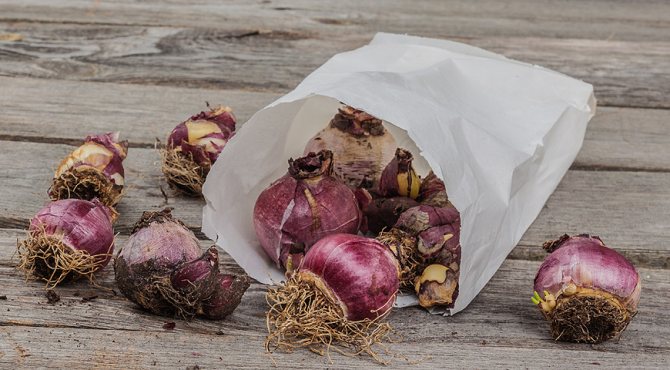

What to do with daffodils after planting: rules for care in the fall
So, you have completed the activity, now what to do with the daffodils? It is not difficult to care for a perennial bulbous plant after planting in the fall, but it is important to perform a number of important care measures.
It is imperative to implement place mulching with bulbs. Mulch will protect them from winter frost and cold weather. As a mulching material, you can use, for example, fallen castings, low-lying peat, rotted sawdust, spruce branches. The optimum layer thickness is 10 centimeters.
Note! In the spring, you need to remove all the mulch from the flower garden.
Besides mulch, it is recommended mark a flower garden with daffodils, so as not to accidentally trample the flower garden after winter. You can mark the boundaries with cones, pebbles, or put pegs and pull the twine.
Otherwise, all daffodil care takes place in the spring and summer. It is necessary to feed, loosen, water, weed, remove faded peduncles. After about 5 years, you need to dig up the bulbs and transplant them to a new place in the garden.


Daffodils are a frequent decoration of the summer cottages of Russian gardeners, since these flowers are unpretentious in care and are beautiful. This type of flowers has a wonderful legend of origin, they have a magnificent aroma and exquisite appearance. Despite their beauty, such flowers easily take root in the ground and do not require much gardener attention. However, it is important to know how to plant daffodils in the fall in order to decorate your summer cottage in a timely manner and without problems.
Bulbs storage rules


Daffodil bulbs after digging
After blooming a daffodil bush, you can start digging out the bulbs. This must be done carefully, so as not to damage the bulbs. Next, they should be cleaned of dried foliage, soil, and put to dry in a warm, well-lit place.
After separating the remaining soil from the bulbs, you need to carefully separate the daughter branches. Softened bulbs affected by various diseases should be separated immediately and discarded. Suitable bulbs must be rinsed with water and placed in a potassium permanganate solution for disinfection for 15 minutes. Then the planting material is dried and ventilated. If the autumn planting of the bulbs is unsuccessful, store them in a dark and warm place during the winter.
If the bulbs are stored in a dark, poorly ventilated area, they will begin to emit a poisonous gas that can harm them.
Is it possible to plant daffodils in spring
Many people think that it is impossible to plant daffodil bulbs in the spring. In fact, this is not the case: you can place the planting material in the ground with the arrival of spring warmth, but you should not expect a quick start of flowering in this case.
Note: Exclusively spring planting is practiced only for thermophilic varieties that require special climatic and soil conditions when forcing the stem.
It often happens that high-quality planting material appears in late autumn or even winter, when it is impossible to land on the garden bed. In this case, it is worth postponing the bulbs until spring and only after the soil has completely thawed, transplant them to the flower bed (Figure 4).
It is extremely important to process the planting material with cold, keeping it for 2-3 months at a temperature of + 1 + 3 degrees. This is directly related to the biological characteristics of the flower. Without the influence of cold, the bulbs simply cannot take root in the soil and bloom in time.


Figure 4. For spring planting, it is better to use already grown seedlings
In addition to cold treatment, there are no special differences between spring and autumn planting. In the southern regions, the procedure can be carried out already in March, but in temperate climates and the middle lane, it is better to postpone the transplanting of bulbs to a flower bed until mid or late April. In general, you need to monitor the condition of the soil: when it completely thaws, you can begin to form a flower bed with daffodils. In addition, experienced florists recommend paying attention to the air temperature: plants root best at temperatures of + 5 + 7 degrees Celsius.
Types and varieties of daffodils with photos and names
According to the international classification, there are 12 groups of daffodils.
Trumpet daffodils
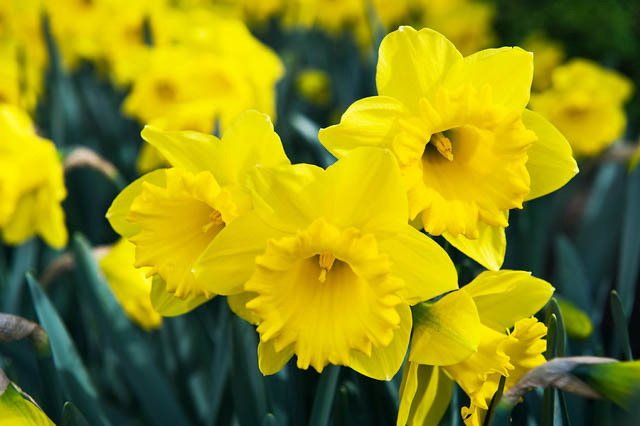

Narcissus tubular variety Dutch master photo
They have a long crown in the form of a tube, which is equal to or exceeds the length of the petals.
Pay attention to the Mount Hood variety.
Large-cupped


Narcissus large-crowned photo
Tubular or funnel-shaped crown, 1/3 longer than the length of the petals.
Notable varieties: Spring Pride, Daydream, Professor Einstein.
Small-cupped
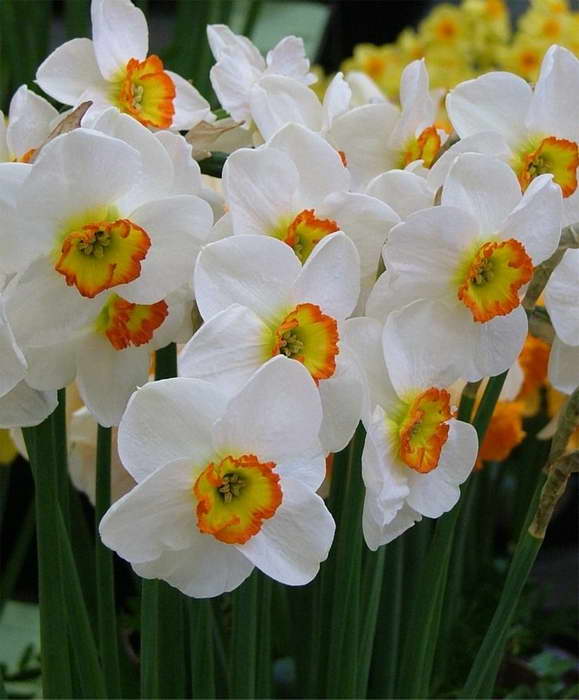

Narcissus small-crowned photo
On the contrary, the length of the crown is 1/3 shorter than the petals.
For example, the Verger varieties.
Triandrus (Triandrus)


Narcissus triandrus photo
Flowers are collected in umbellate inflorescences of 2-4 pcs.
Varieties: Thalia, Hawera, Ice Wings.
Terry (Double)
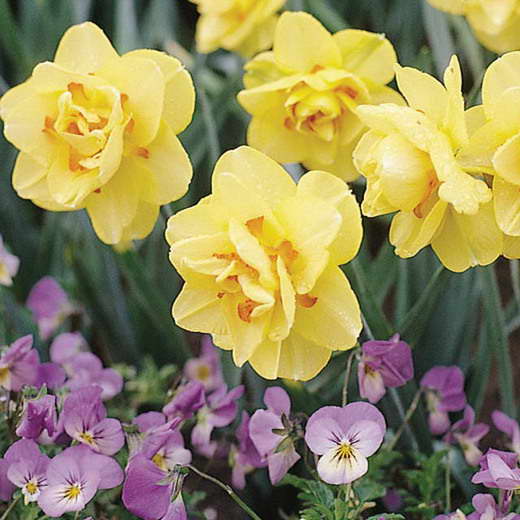

Daffodil terry variety Narcissus Tahiti photo
Includes all double-flowered varieties.
Sorts: Rosy Cloud, Petit Four, Gay Chellenger, Pink Paradise, Yellow Cheerfullness, Rosy Cloud, Gay Kybo, Yellow Cheerfulness, Irene Copeland, Texas, Rip Van Winkle, White Lion.
Cyclamineus
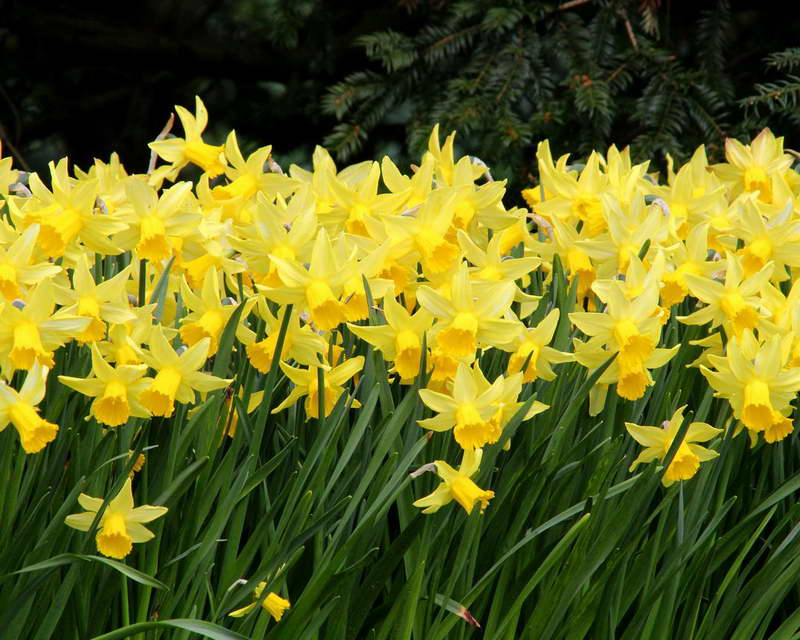

Narcissus cyclamen variety Narcissus February Gold photo
The crown is long, the petals are strongly bent back.
For example, February Gold.
Jonquilla
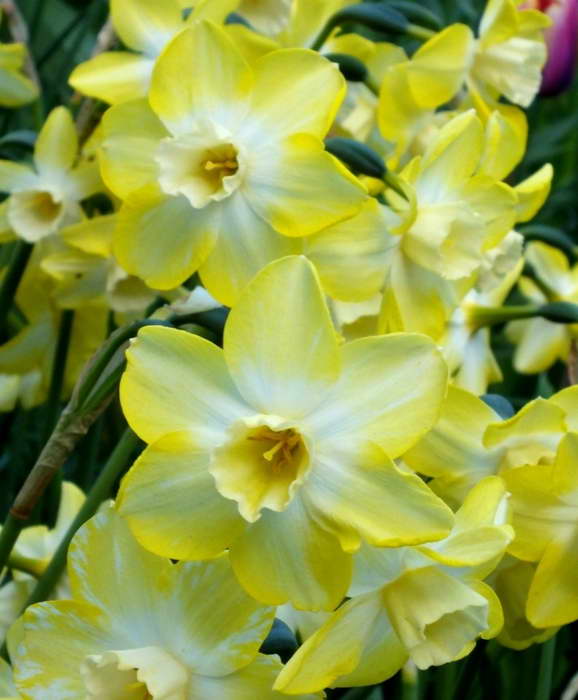

Jonquil's daffodil cultivar Narcissus Pipit photo
Flowers are small, on one peduncle there are 2-3 pcs.
Pipit cultivar.
Tazetta (Tazetta)
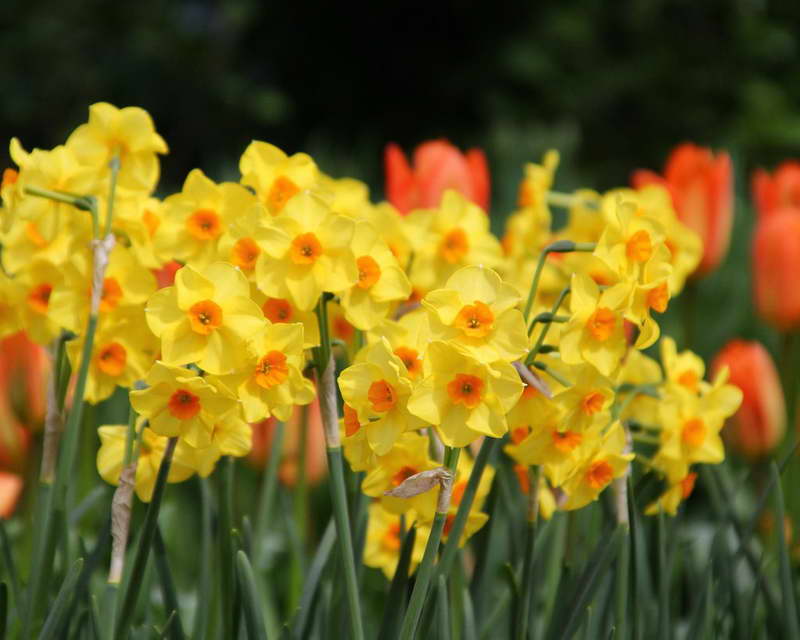

Daffodil Narcissus Scarlet Gem photo
Corollas are medium in size, one inflorescence can contain about 12 pieces.
Scarlet Gem is notable.
Poetic (Poeticus)
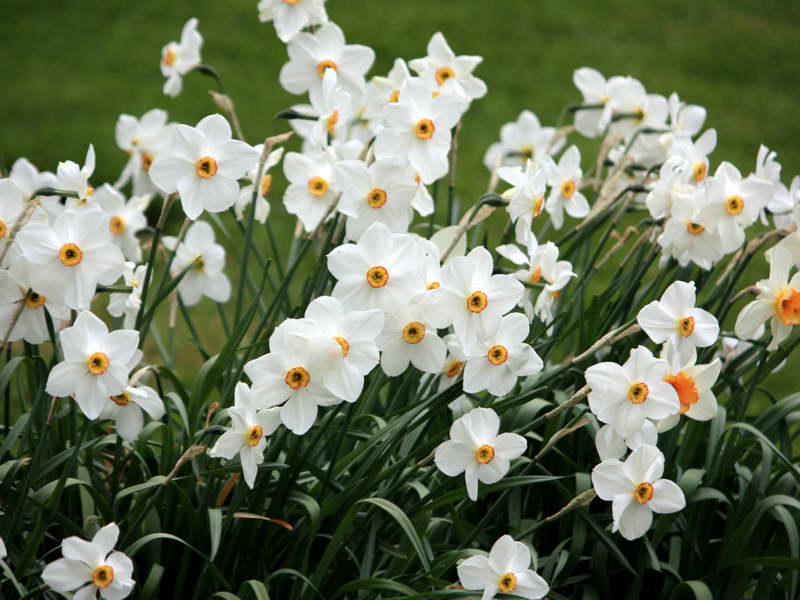

Poetic daffodils photo
Single flowers with a short crown, snow-white.
Split-Corona


Crowned daffodil photo
The crown is divided into lobes.
Others
They have different characteristics inherent in different previous groups.
Benefits of autumn planting
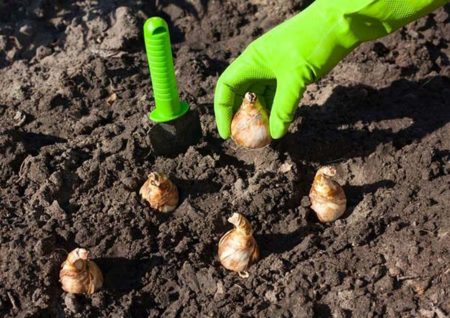

The life cycle of flowers has a short dormant period, so it is better to plant them before the roots begin to actively grow. If the flowers are planted at the right time, then the bulb has time to grow strong roots, and then the plant survives the winter well. During the winter, the flower gains strength for rapid growth in the spring. In addition, the bulbs for autumn planting do not need to be placed for several days in the cold, as for example, during spring. During the winter, the planting material acquires stable immunity, subsequently does not get sick, and the flowering itself lasts longer.
Attention! When planting daffodils in the fall, you can lay an interesting design for a garden bed. In the spring, it will only remain to complement it with other colors.
Landing place
Daffodils feel most comfortable in open sunny areas, light shading is acceptable. Under the influence of direct sunlight, the flowers will be brighter, and in shade, the flowering is longer.
The soil requires a moisture-permeable, neutral reaction. Ordinary garden soil is perfect, and loam fertilized with humus or compost is also suitable. If the soil reaction is alkaline, add dolomite flour (200 g per 1 m²), acidic soil should be diluted with wood ash (1 glass per 1 m²).
It is better not to plant in a place where bulbous plants have recently grown, as well as perennial chrysanthemums, phloxes, asters. Planting is favorable after the growth of legumes, nightshades, cereals, cucumbers and peonies.
General information and features of reproduction
Translated from Greek, the name "daffodil" means to intoxicate. This was the name of the flower because of its specific aroma, which is able to charm any person. Outwardly, the flower looks rather fragile and delicate. It has a yellow core, around which are located oblong petals with pointed ends. The size of the daffodil reaches 40-50 cm in height, the leaves are elongated, directed upwards or slightly tilted.
Daffodils are grown for subsequent cutting or creating flower arrangements in the garden. They look great in mixborders and on alpine slides, in flower beds and rabatki.
In the middle lane, flowering occurs at the end of April and continues until the end of May. The growing season ends at the end of July. Then the stems dry up and die off. The bulb remains in the ground and continues to live.
Dig up the bulbs when the foliage of the daffodils has completely faded and the bushes begin to decay. The remnants of leaves and stems are removed from the excavated planting material, left to dry in a dark, ventilated place. When the bulbs are dry, they are cleaned of soil residues and disassembled into separate parts.
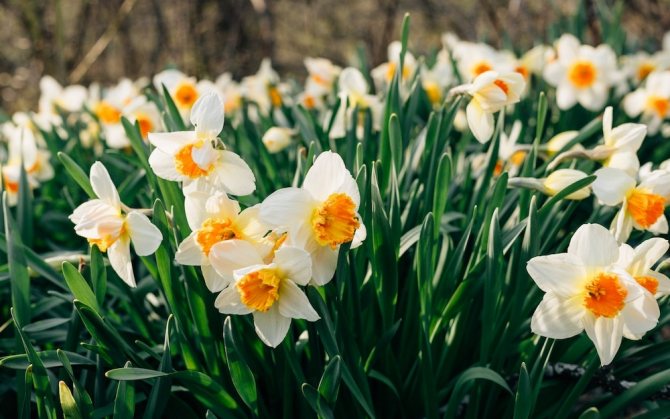

What daffodils look like
Daffodils, unlike many flowers, love shaded areas. Reproduction takes place by bulbs in the open field. Plants are planted in spring or autumn, although the latter option is preferable. In this case, the planting material has time to take root, and with the onset of the body, it actively grows. Spring breeding is only suitable for thermophilic varieties.The bulbs are pre-hardened. To do this, they are kept for at least two months at 1-4 degrees.
How to bloom by March 8
Since daffodils are considered to be a kind of symbol of spring, they are often planted in advance so that the flowering period coincides with the 8th of March. It should be clarified right away that in natural conditions, daffodils do not bloom so early, especially in temperate and northern climates. The only exception can be the southern regions, where spring comes early, and the plants, accordingly, wake up with the arrival of the first warmth.


Figure 5. Winter forcing of flowers
To grow daffodils by March 8, you need to choose the right planting material and take into account the biological characteristics of the flowers. In other words, you will have to create conditions under which the plants will wake up and begin to bloom before their natural time.
Note: For distillation, special bulbs are bought by March 8, and immediately after they are purchased, they begin to plant them in a nutritious soil mixture.
To obtain flowering plants by the beginning of March, in mid-December, the temperature for the planted bulbs is reduced from + 5 + 9 degrees to + 3 + 4. This will help delay the development of the sprouts and stimulate the plants to release flower buds earlier. Otherwise, care for daffodils in pots should be as usual, in particular, periodically watered when the topsoil dries up. It is not necessary to feed the plants during direct forcing, since nutrients are introduced into the soil directly during planting (Figure 5).
Two weeks before the expected start of flowering, the pots with plants are transferred to a warm room and placed on a well-lit windowsill. This will reproduce the onset of spring and the bulbs will begin to sprout and bud. When the flowers open, it is advisable to lower the temperature to + 11 + 12 degrees, so that the blossoming inflorescences persist longer.
Step-by-step instructions for planting daffodils in open ground are given in the video.
How to choose the right time for boarding
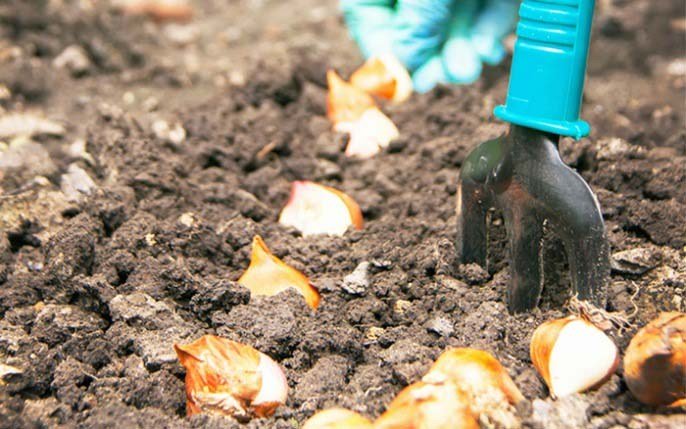

Planting daffodil bulbs in the fall
It is important to know when to plant daffodils in the fall so that the bulbs can take root in the ground and do not freeze if the soil temperature is too low. This question depends on a number of characteristics of the plant, for example, on its type. Botanical daffodils should be planted in early to mid-September as this is the time when the soil temperature is optimal for keeping the bulb. Flowers with large bulbs are best planted towards the end of the first month of autumn.
Planting material processing rules


Potassium permanganate solution for processing bulbs
Before planting bulbs in the fall, you should do their processing. The nematoda is the main enemy of the planting material. Of course, you will not be able to consider it, but further measures will help to destroy the pest and save your flower garden. The bulbs should be processed about two weeks after digging out of the ground. If you carry out the procedure later, there is a high risk of damage to the root system and other components of the planting material.
Processing is carried out in two stages:
- Process the bulbs with boiling water at about 43 degrees Celsius for two hours. Potassium permanganate can be added to the solution: this will serve as additional protection against microorganisms and nematodes.
- Treat with 35% ethanol solution for five minutes. In this case, the affected bulbs float (this means that now they are only suitable for ejection), and high-quality ones sink.
Having familiarized yourself with the main preparatory questions, you can start planting daffodils in the fall. Bulbs are planted on a principle similar to planting other types of plants. The main thing in the matter of planting daffodils is the moment of choosing the bulbs, preparing the planting material and caring for the bulb immediately after planting in the ground.
Mistakes when growing daffodils
Experienced growers and beginners alike sometimes make mistakes in growing daffodils.
- Daffodils love moisture, but excess of it provokes decay. Therefore, ensure that there is sufficient drainage both in the soil and in the pot.
- Poor quality planting material leads to plant death or growth retardation.
- If you cut off the leaves of a wilted flower too early, the bulbs will not accumulate useful and important substances for growth in the scales.
- Have chosen a place for daffodils in the shade or in a draft - be prepared for the flowers to wither very quickly.
- Did you self-fertilize and has too much nitrogen in it? This means that many leaves and few flowers will grow.
- Do not wait until the flowers are crowded, plant them more often.
- Transplanted bulbs may also not bloom this year.
Grow flowers correctly, make no mistakes and admire these beautiful plants for several years. For more information and understanding of the process of growing daffodils, watch the video provided on this page.
Principles of correct wintering of daffodils and spring work


Shelter a flower bed of daffodils with dry leaves
Before the onset of frost, it is important to take care of soil mulching: this procedure will help the seedlings survive even the most difficult periods of frost. In Siberia and the Urals region, the thickness of the mulch layer should be increased to fifteen centimeters.
In the Moscow region, planting is carried out in mid-August - September. In this case, you should also take care of the normal content of the mulch layer. If the planted varieties are not resistant to cold, you can use lutrasil flooring. You can remove it immediately after the snow melts.
It is necessary to open plantings in spring gradually, as the snow thaws. Timely care should be taken to cover and remove excess soil particles in order to avoid unnecessary stretching. After removing the shelter, care should be taken to introduce nitrogenous fertilizing into the plant. To do this, you can use dry ammonium nitrate, which must be absorbed into the soil with moisture. This can be artificial watering in dry weather or natural precipitation. This should be done like this: water, and then prepare fertilizer with saltpeter with the calculation of a spoonful of saltpeter in a bucket of water. Due to the fact that the root of the daffodil is deep enough, it is inappropriate to use mineral fertilizing.
Further care
Fertilizing is prohibited immediately after planting. Growth stimulants should not be used either, as the bulb will start to germinate too early and then freeze. If during planting you put fertilizers in the soil, then they will be enough even until spring or even until next fall.
Excess moisture is bad for the bulbous flowers, so cover the bed with plastic wrap in case of constant cold rains. The film will prevent waterlogging of the earth. Whenever possible, try to loosen the soil at least once a week so that fresh air gets into the soil, because the tubers need it.



